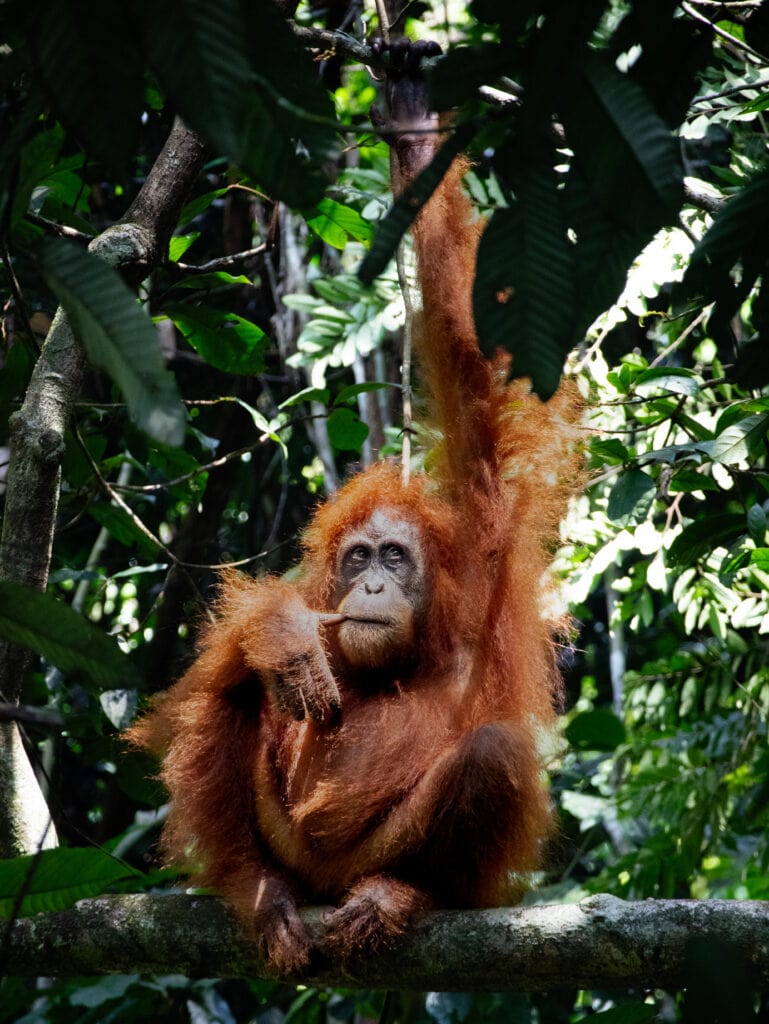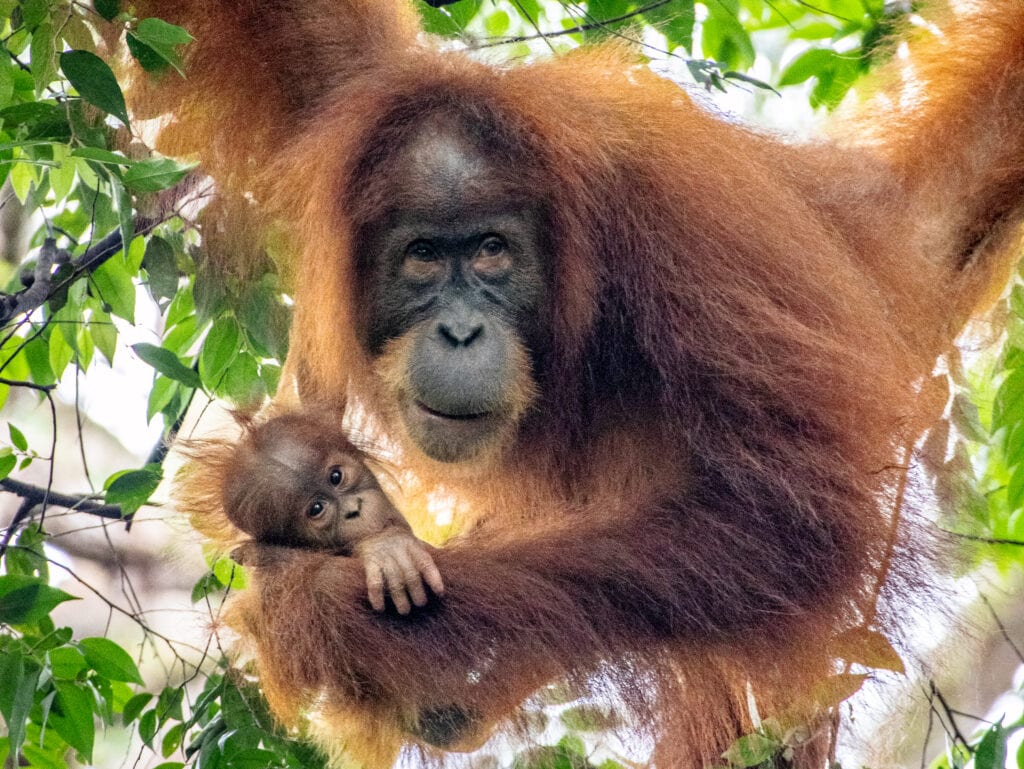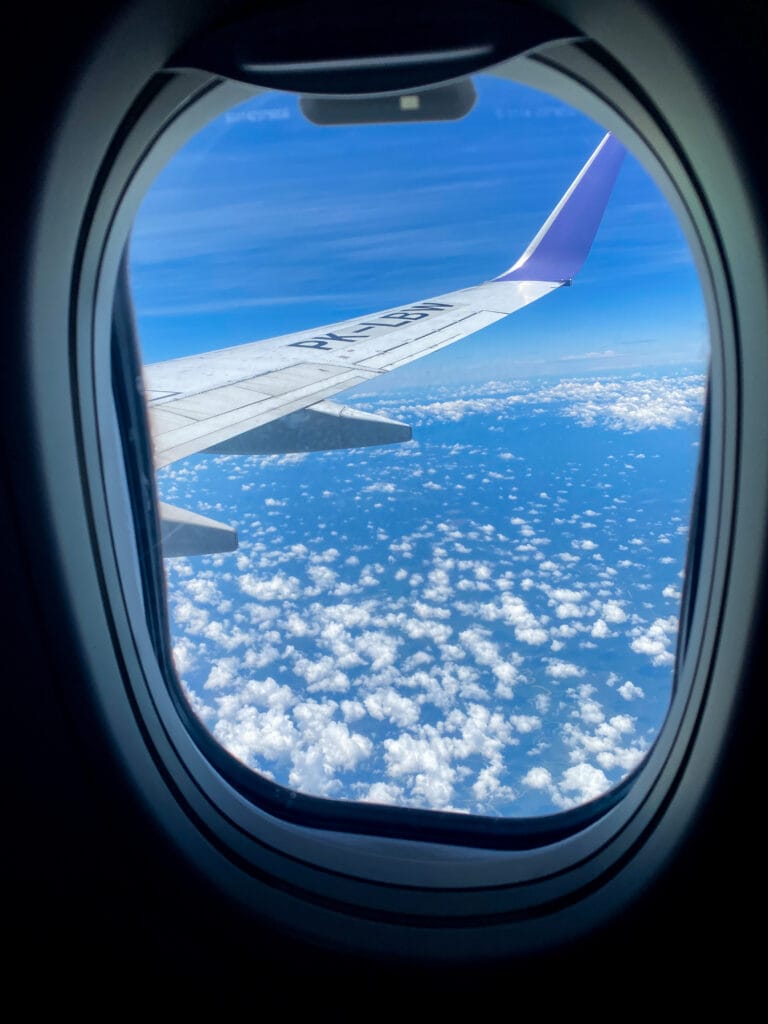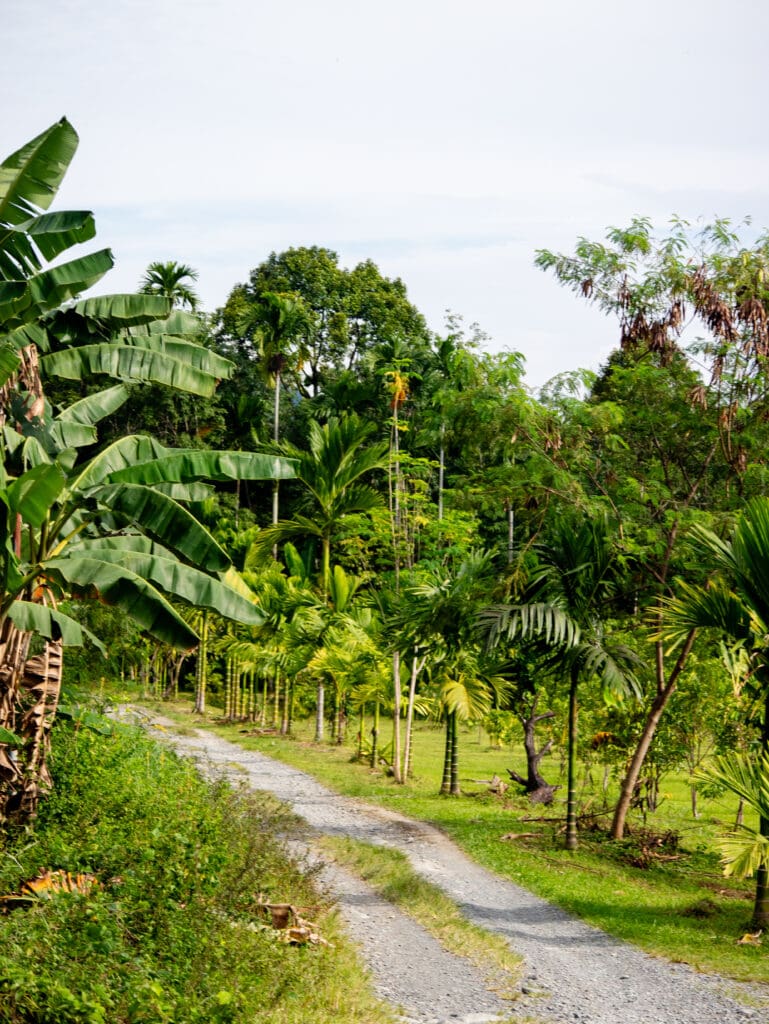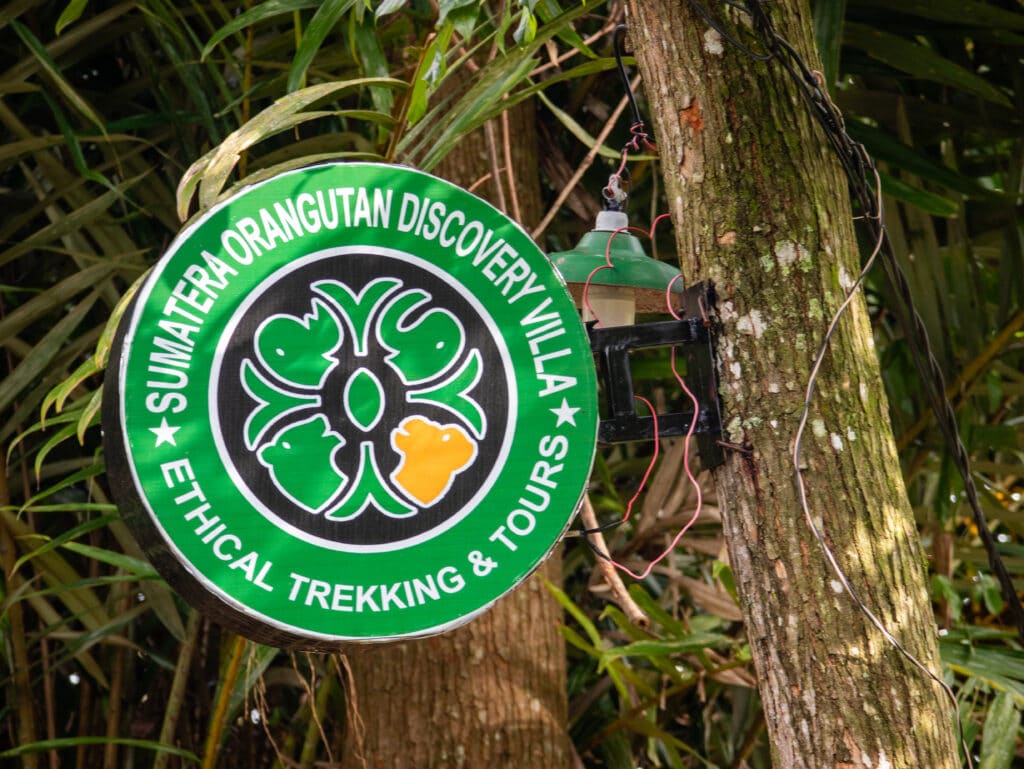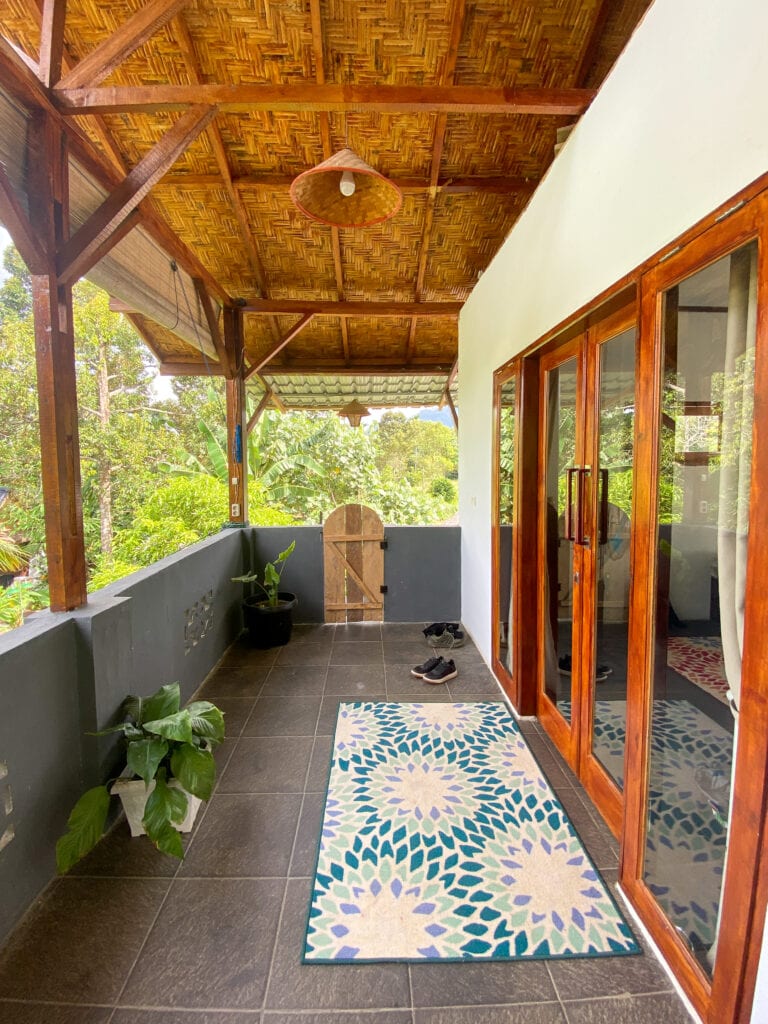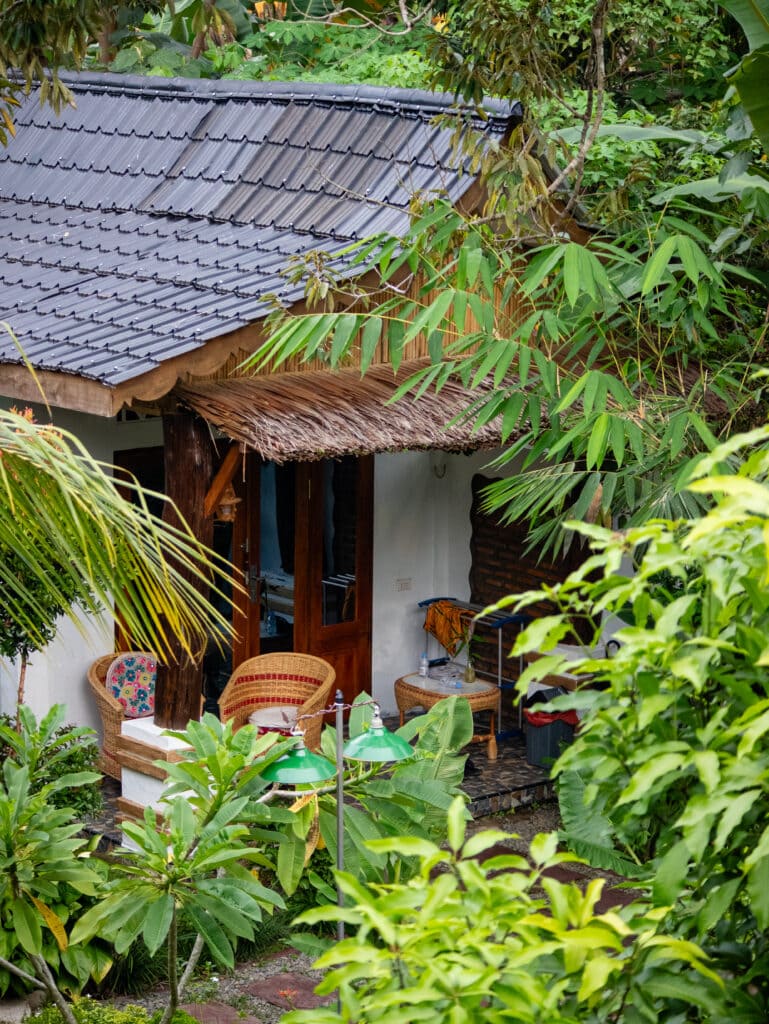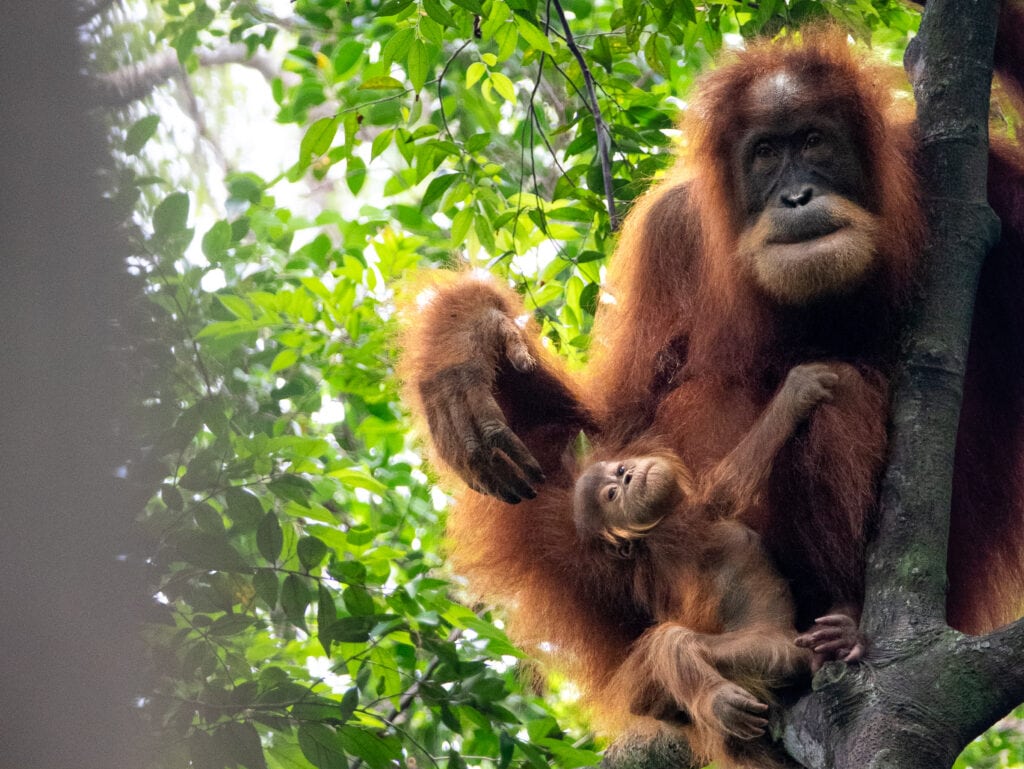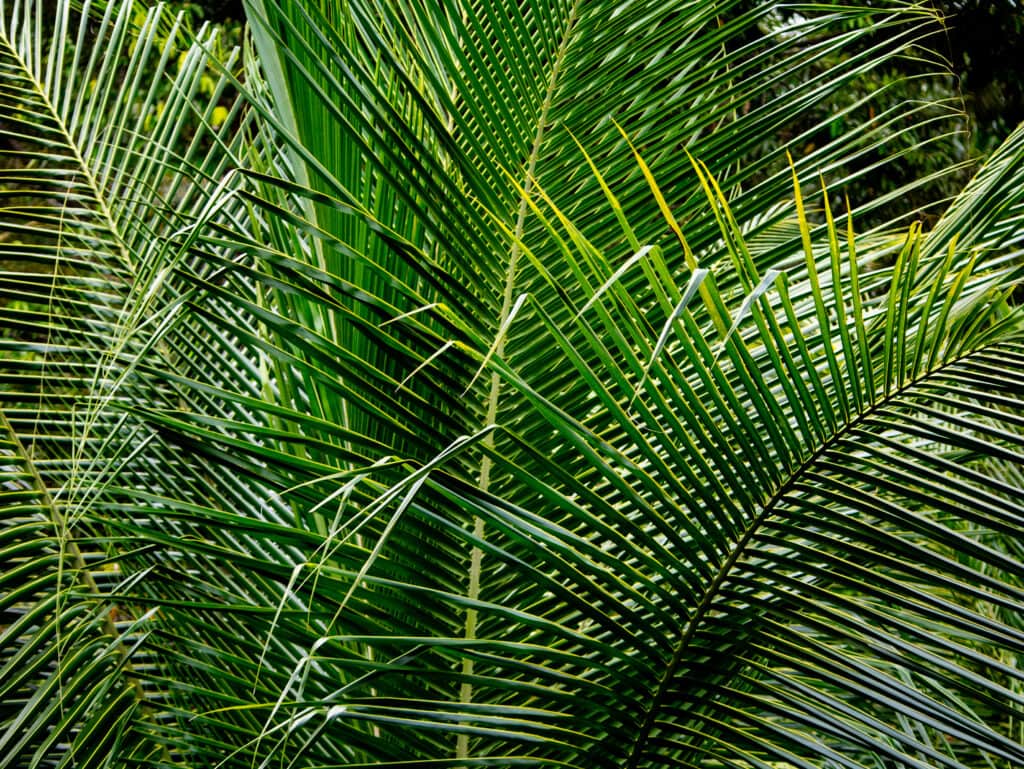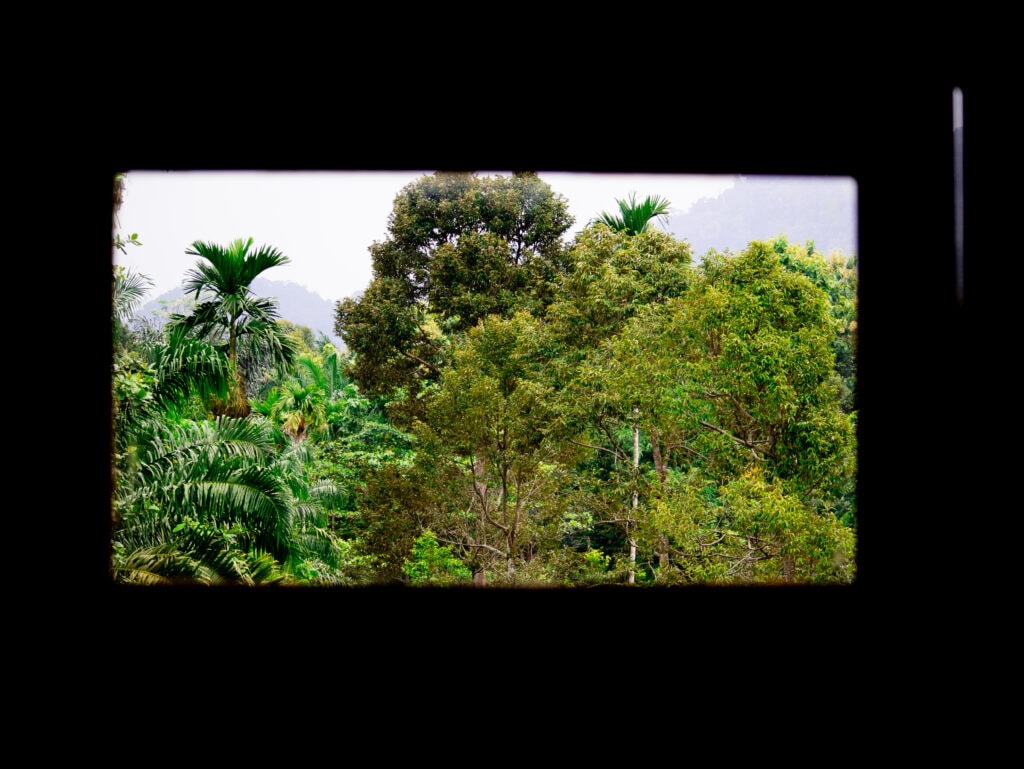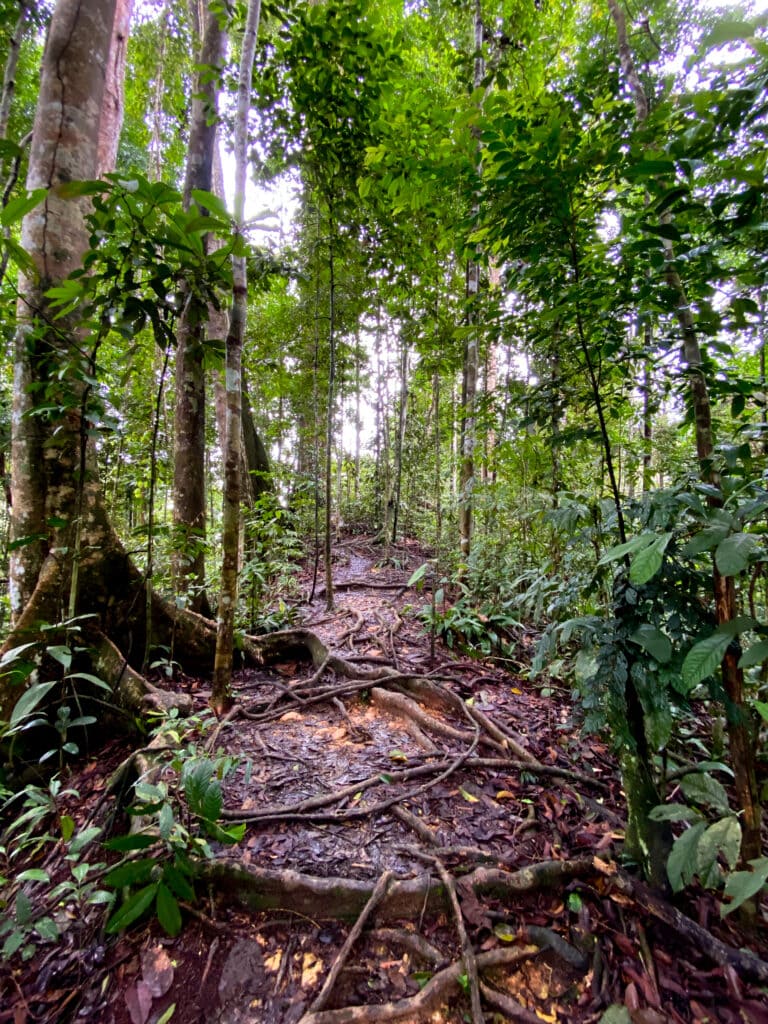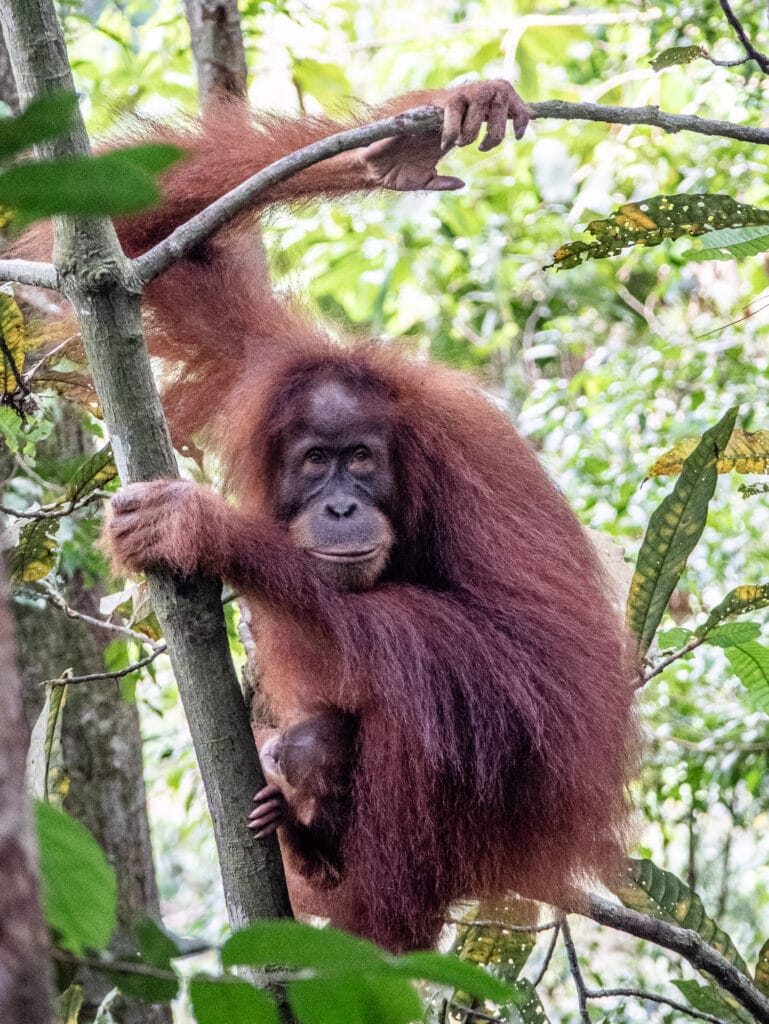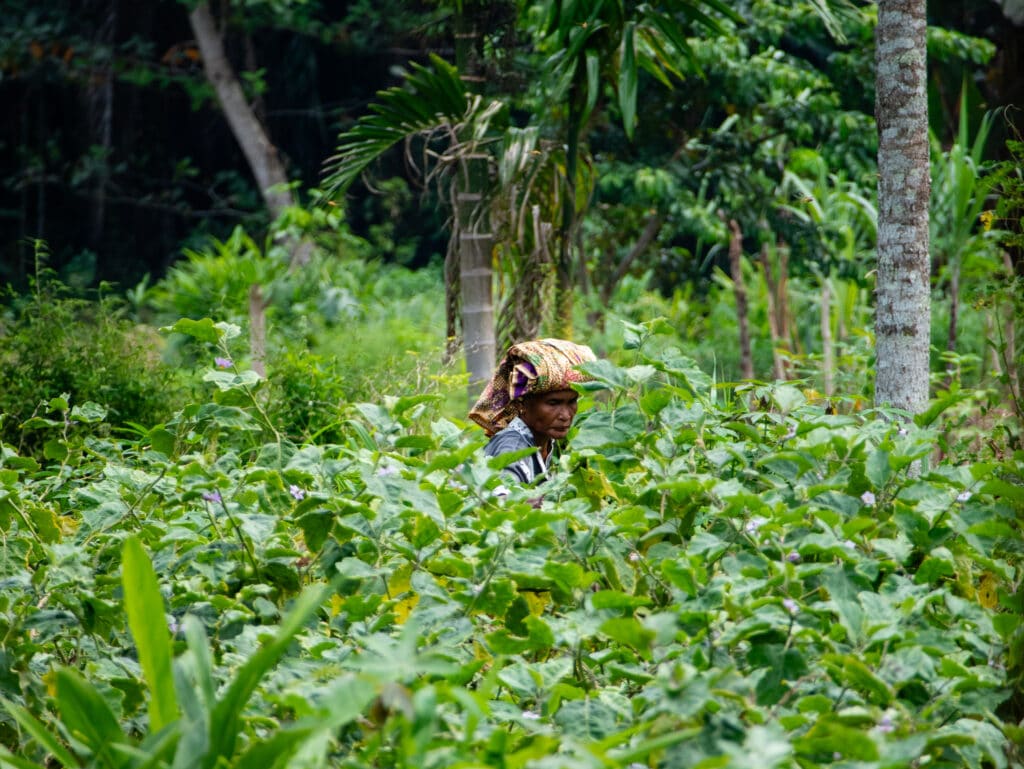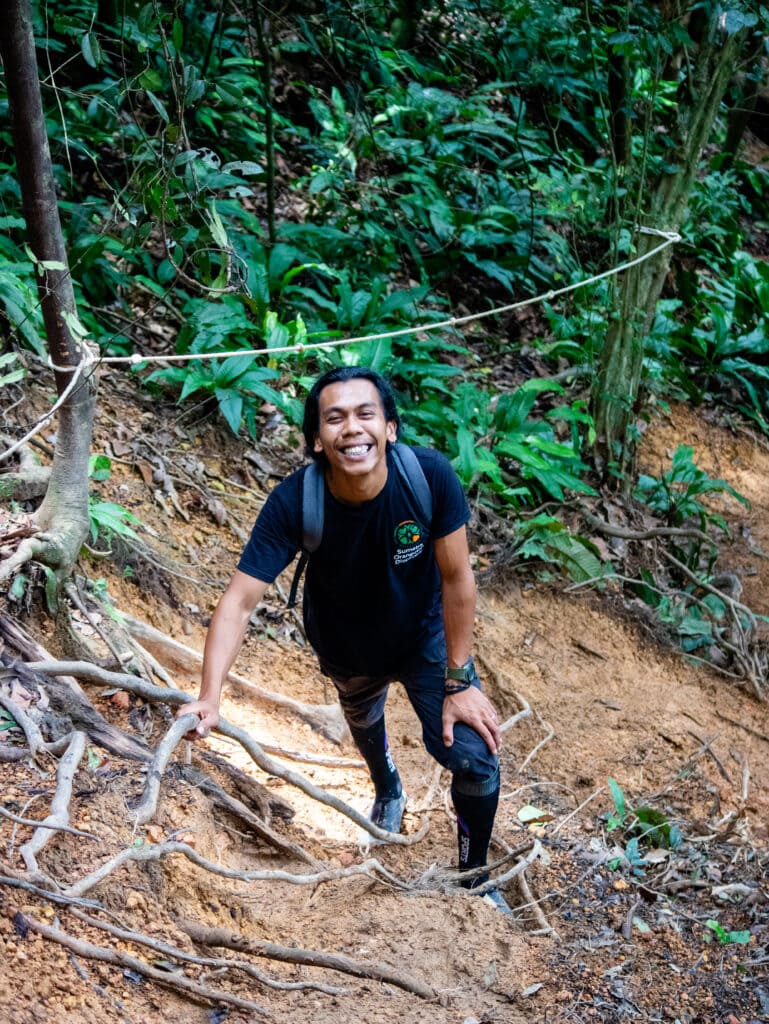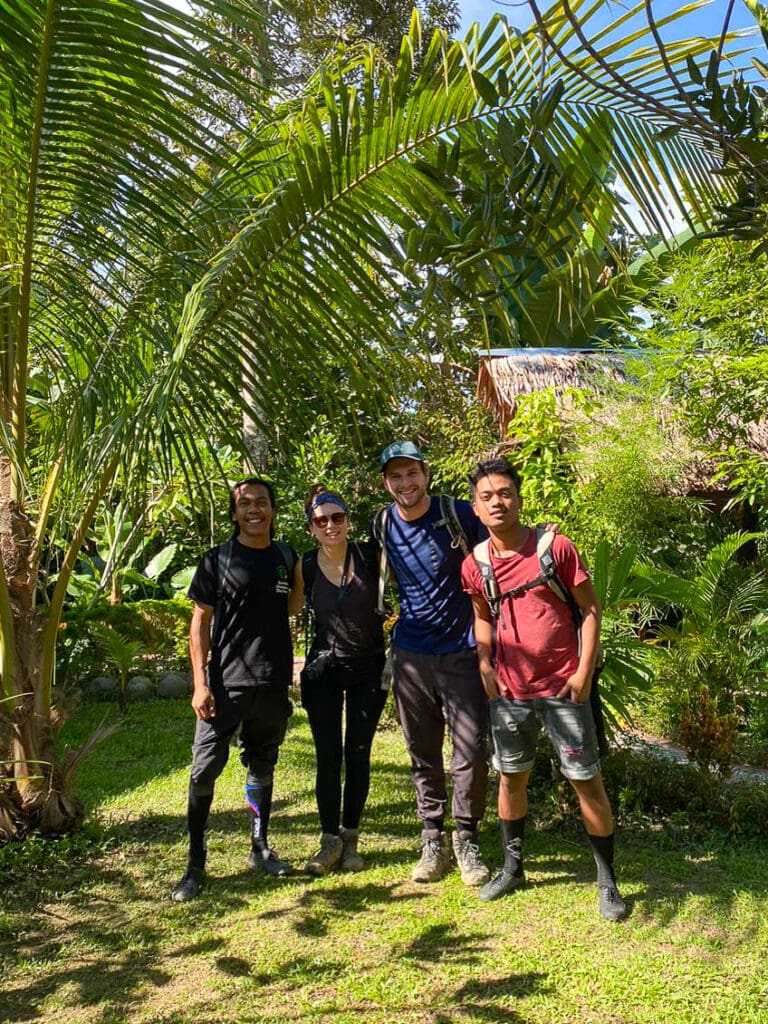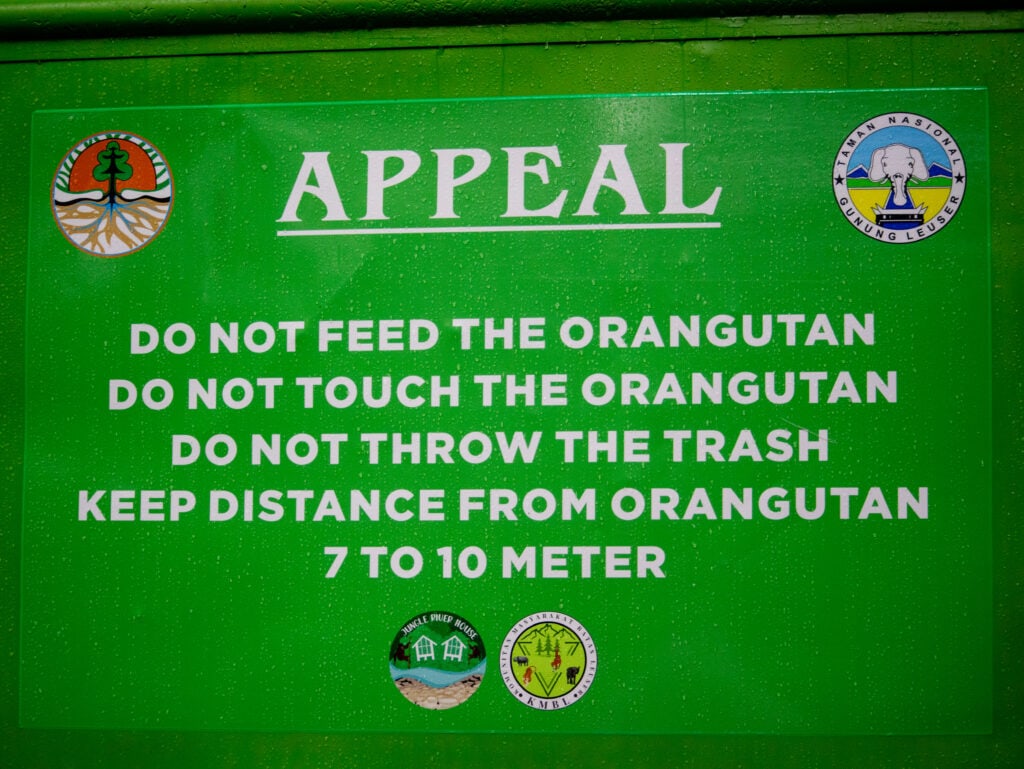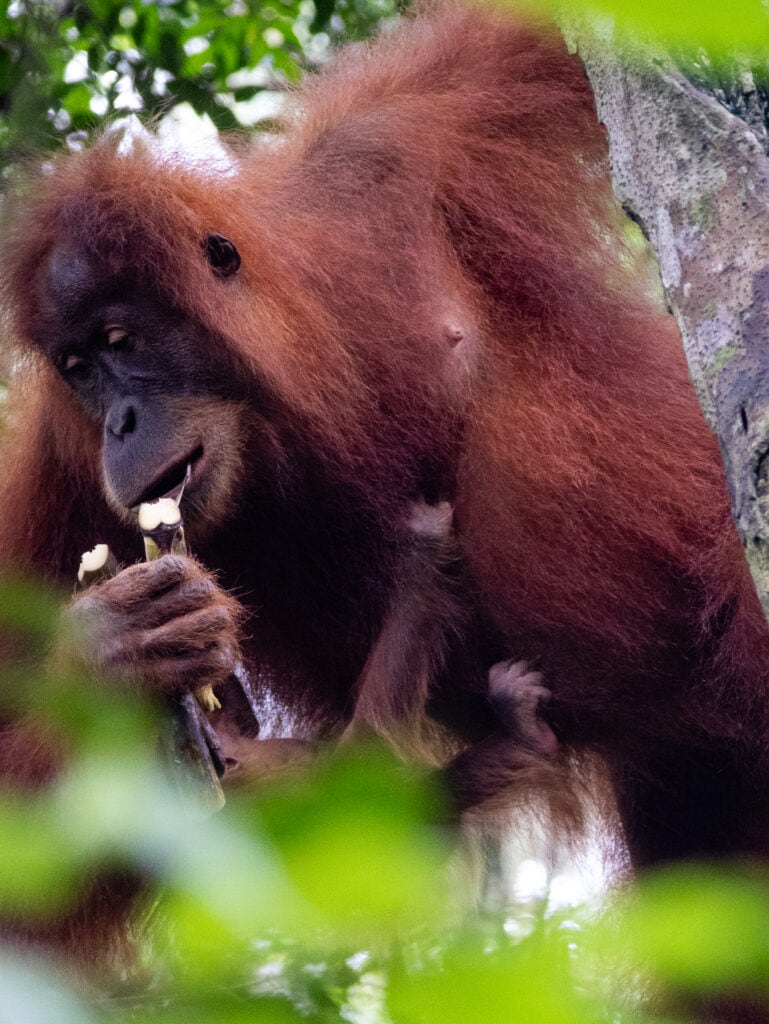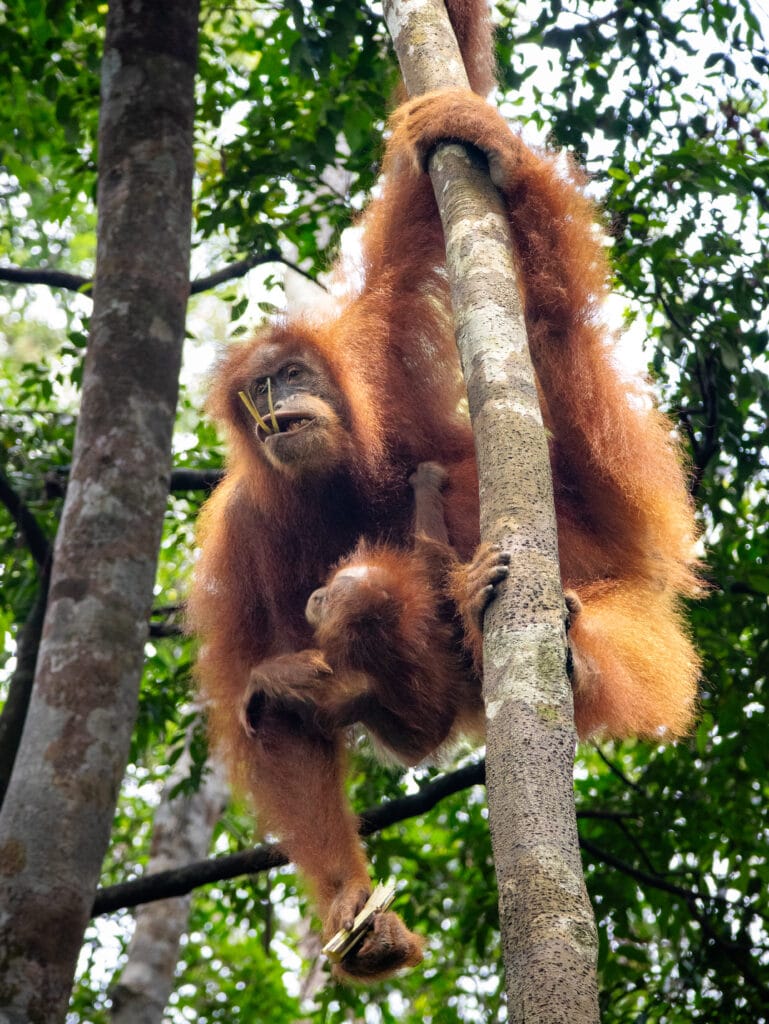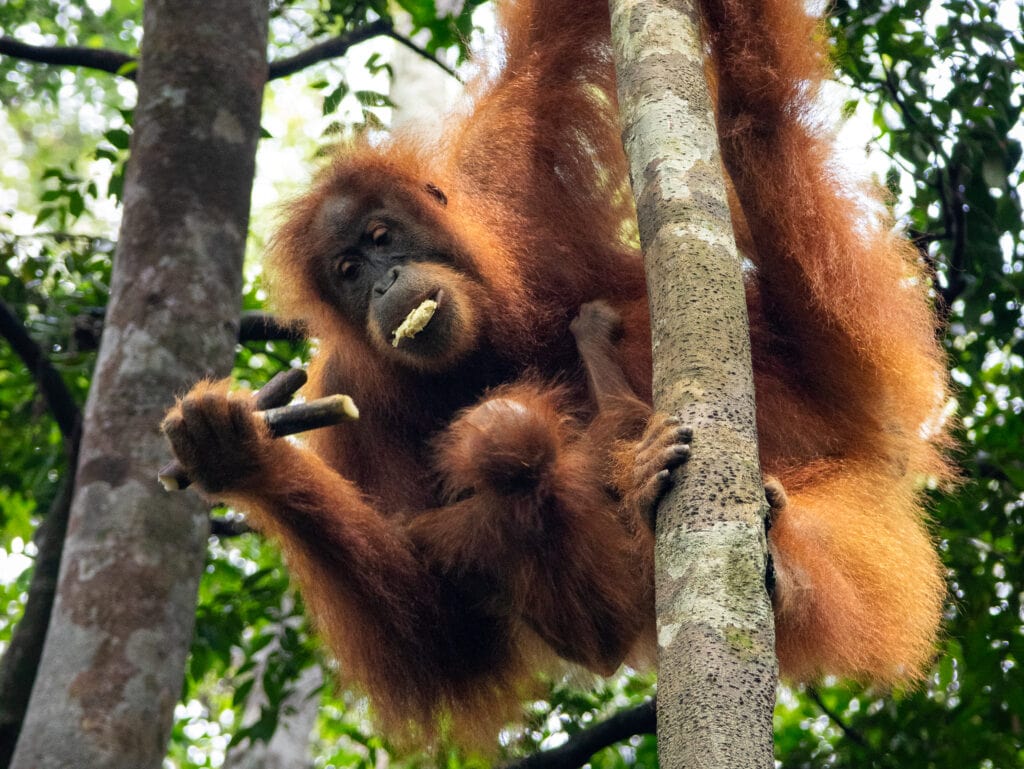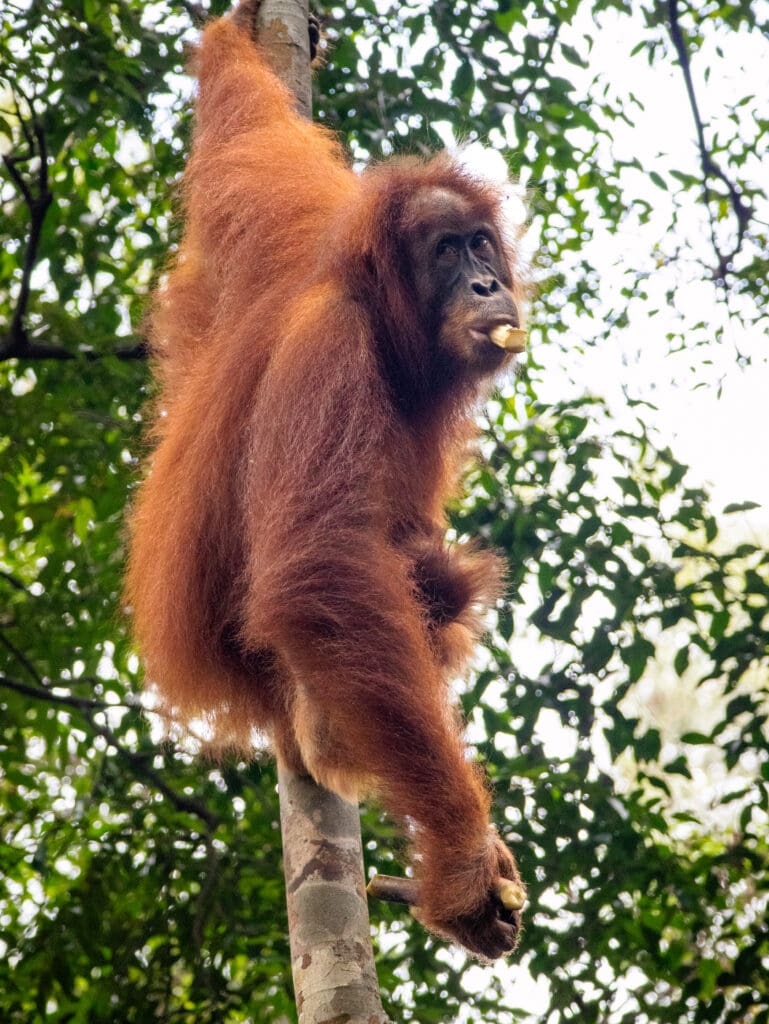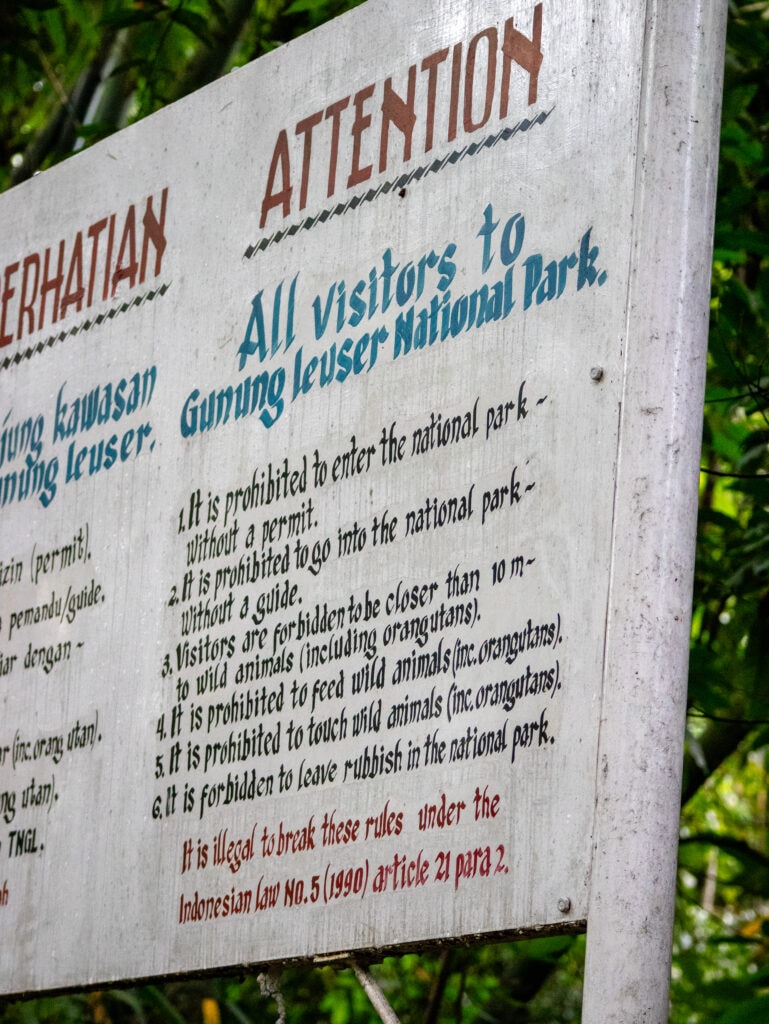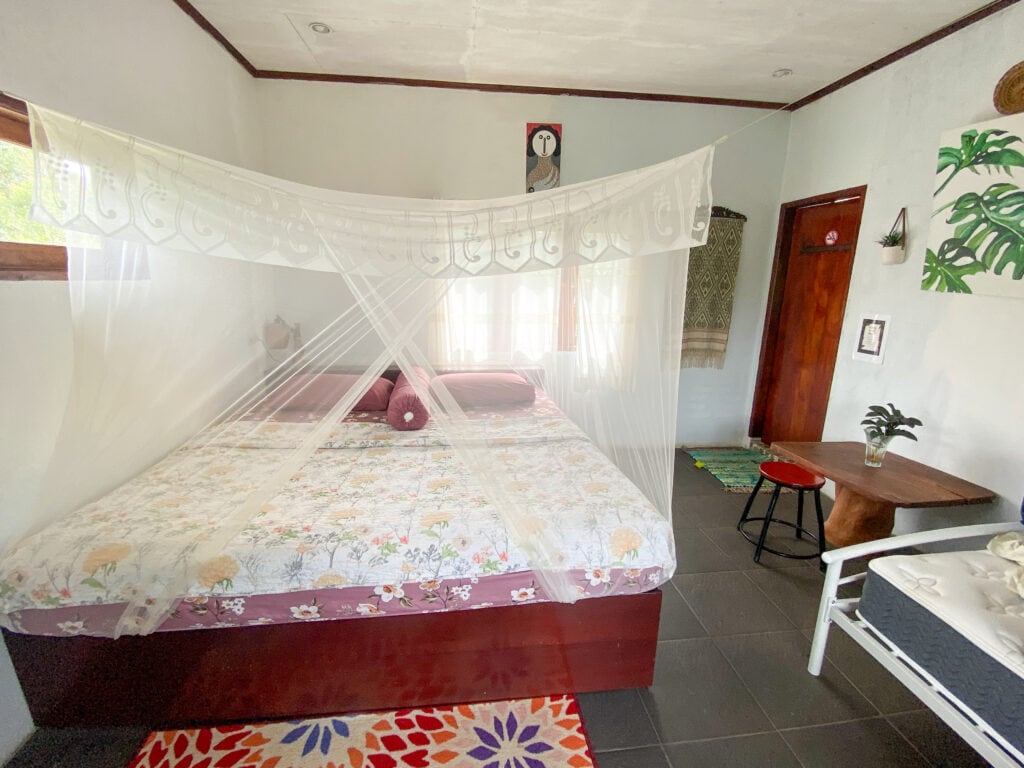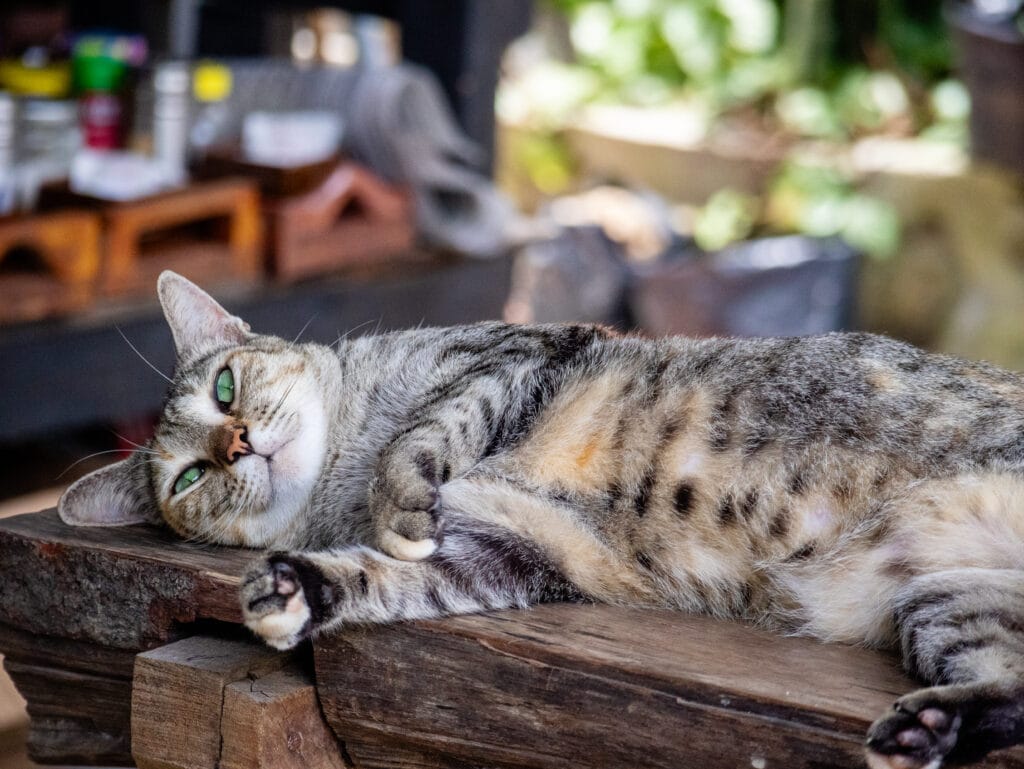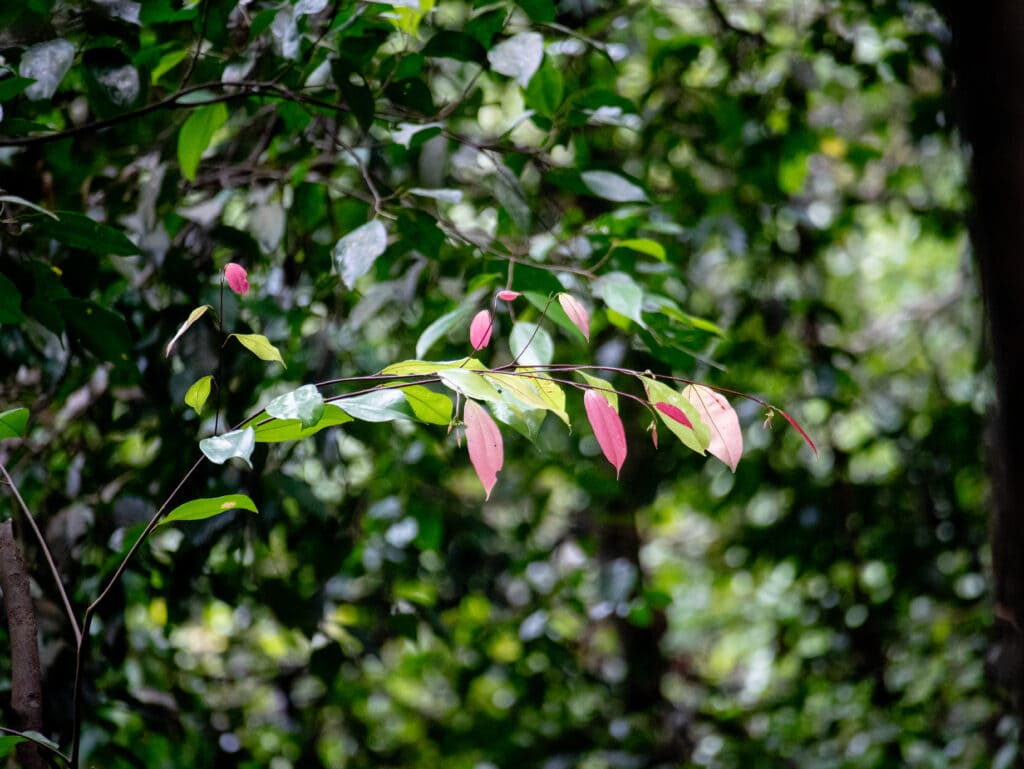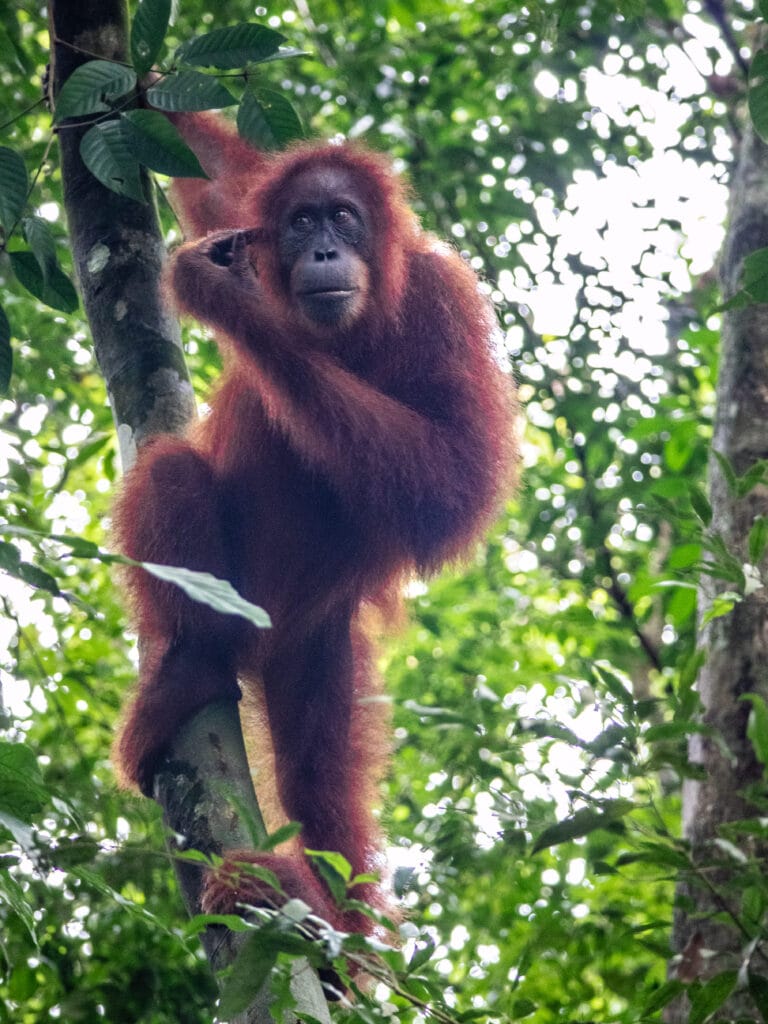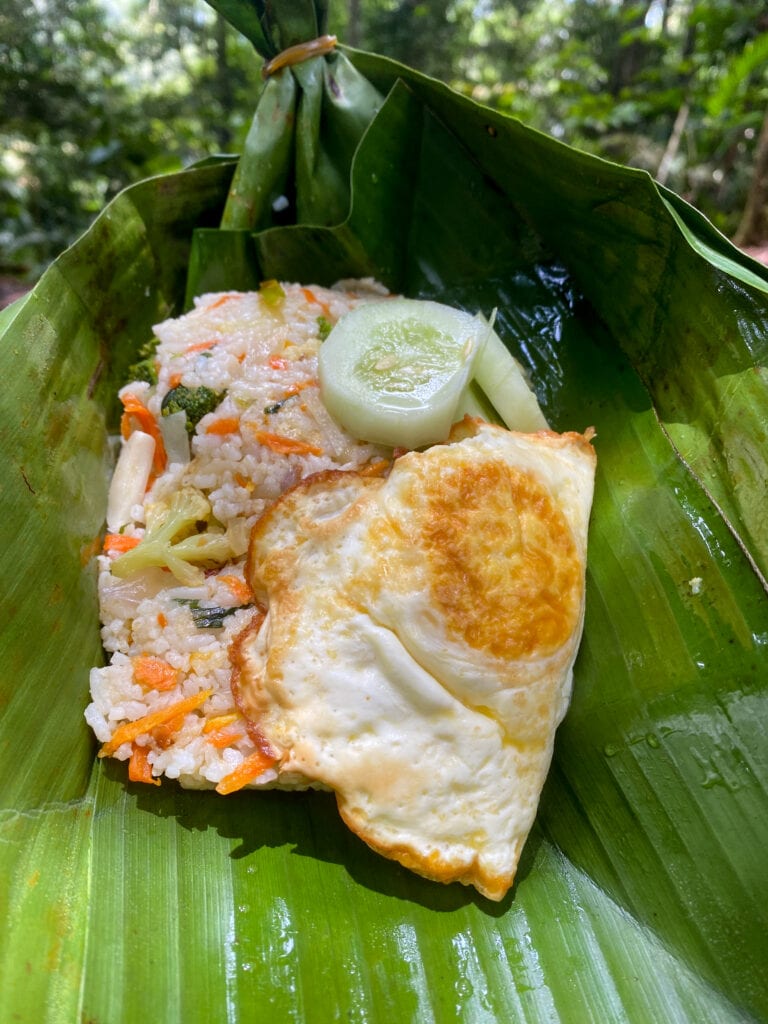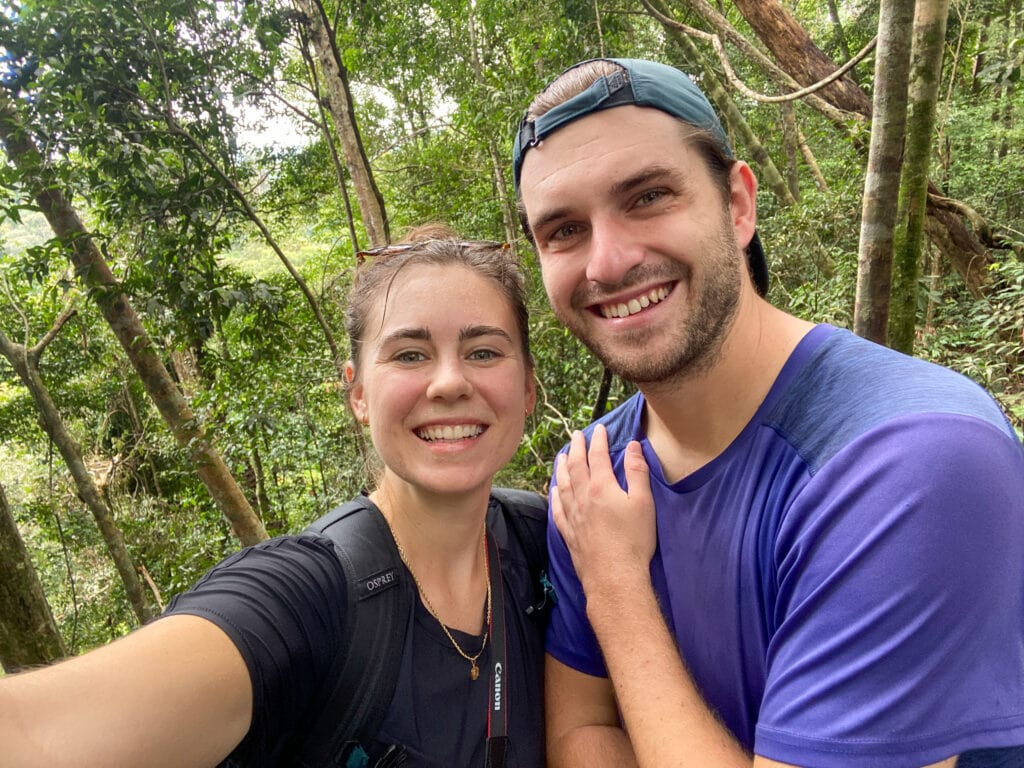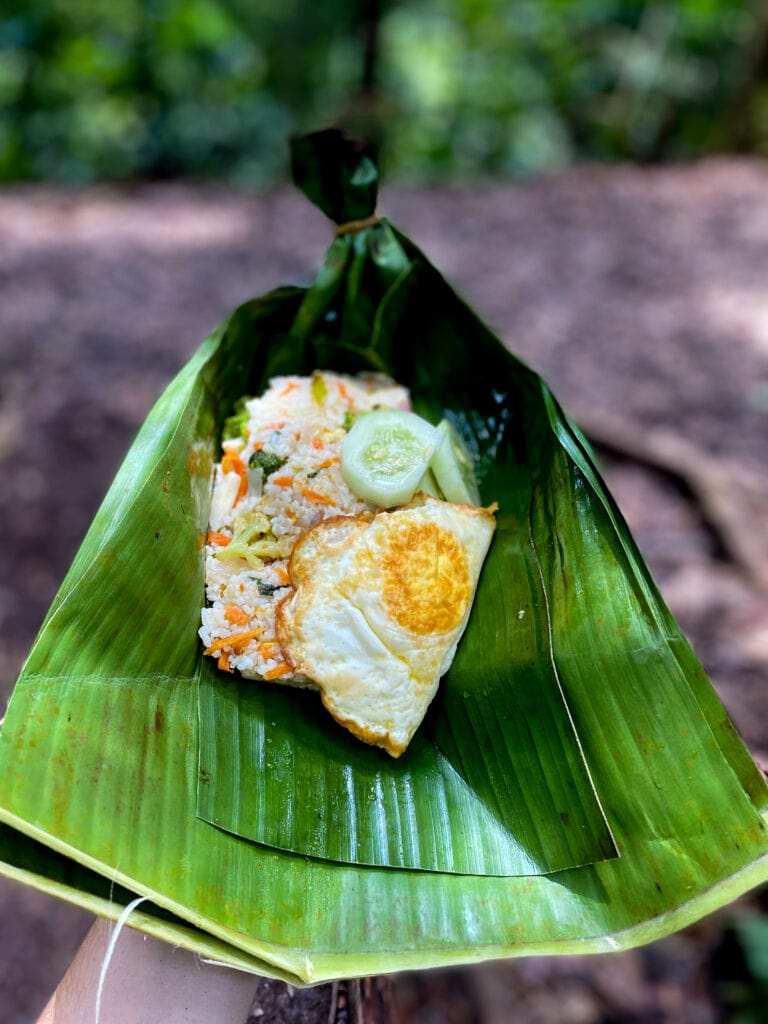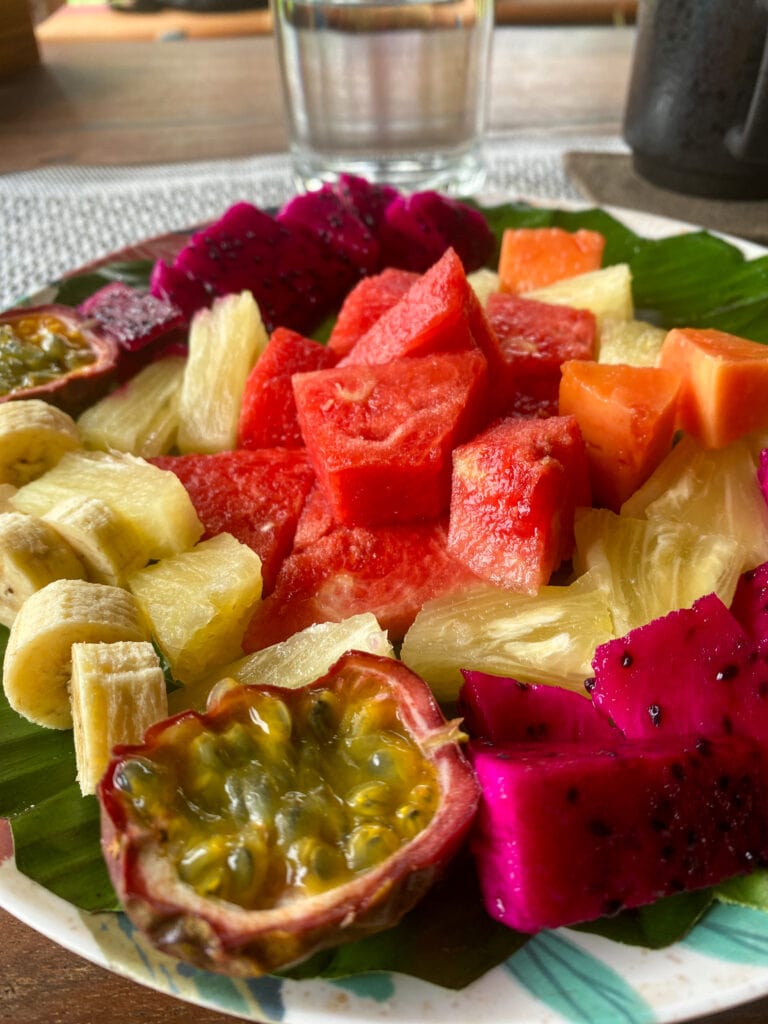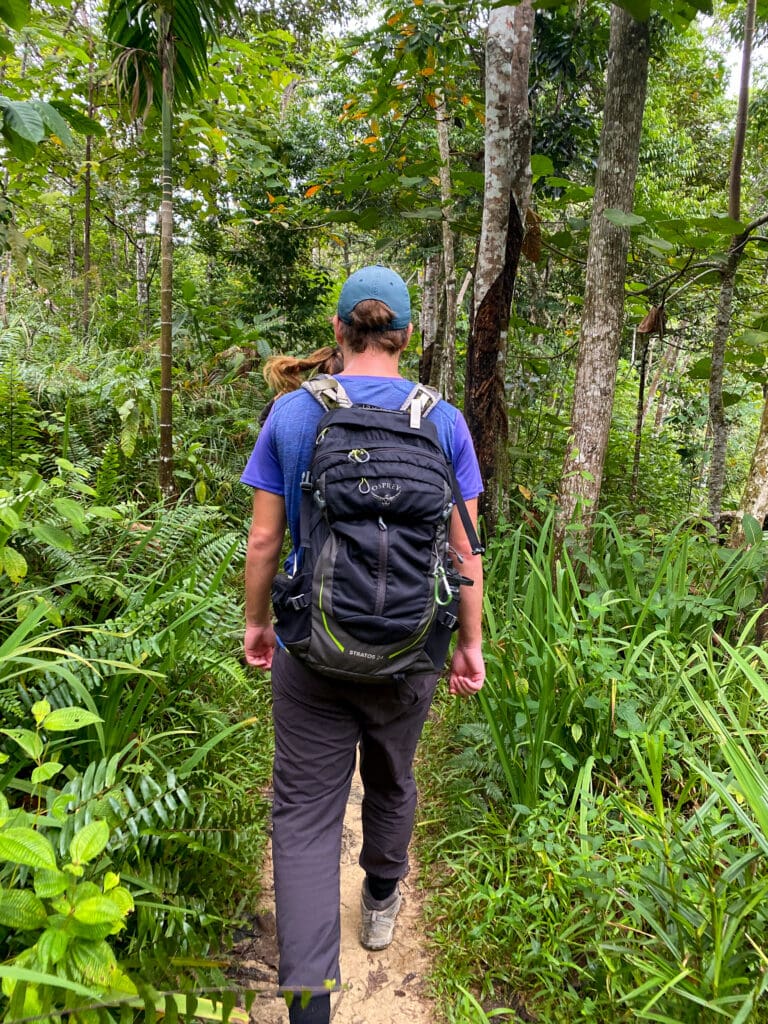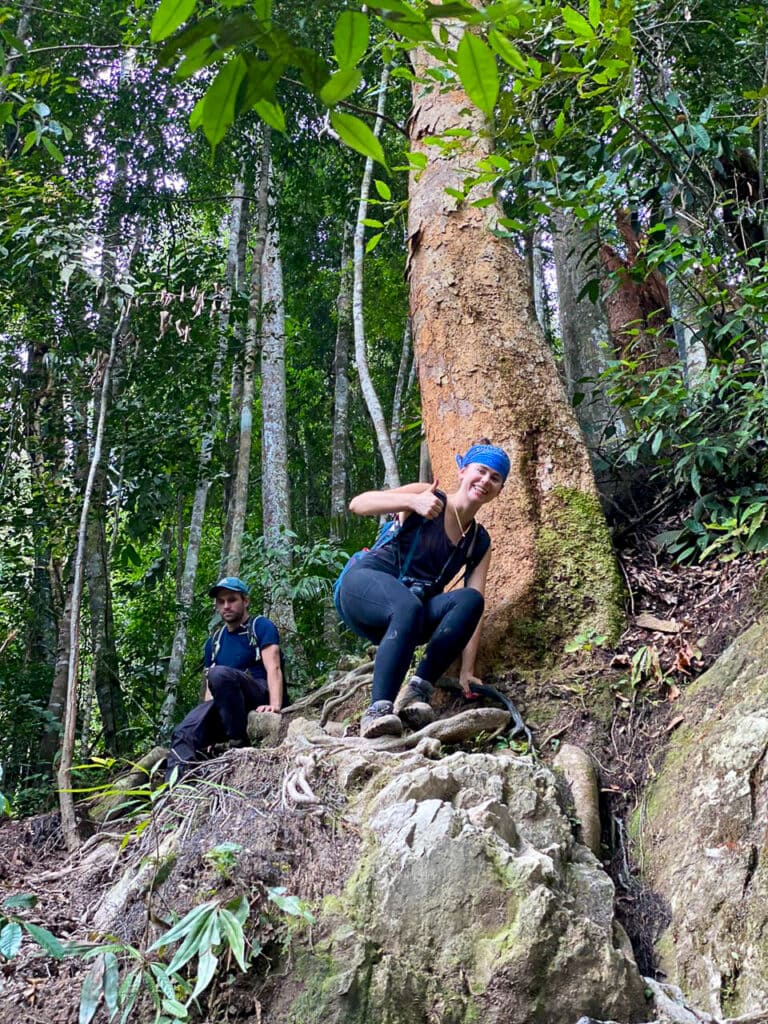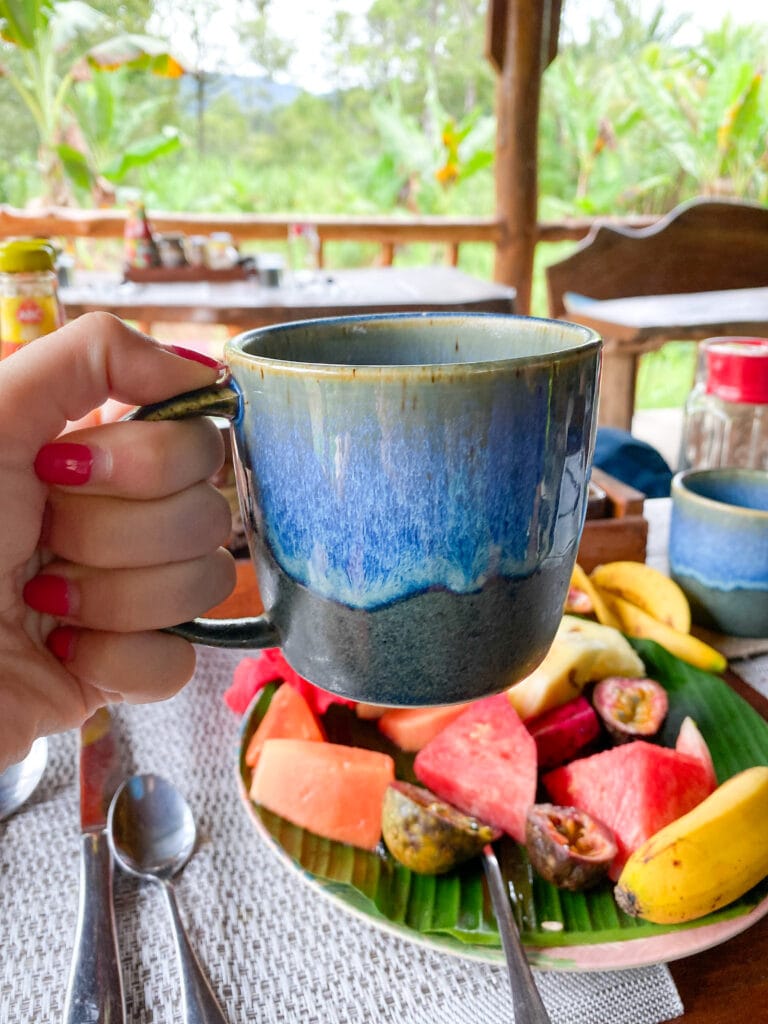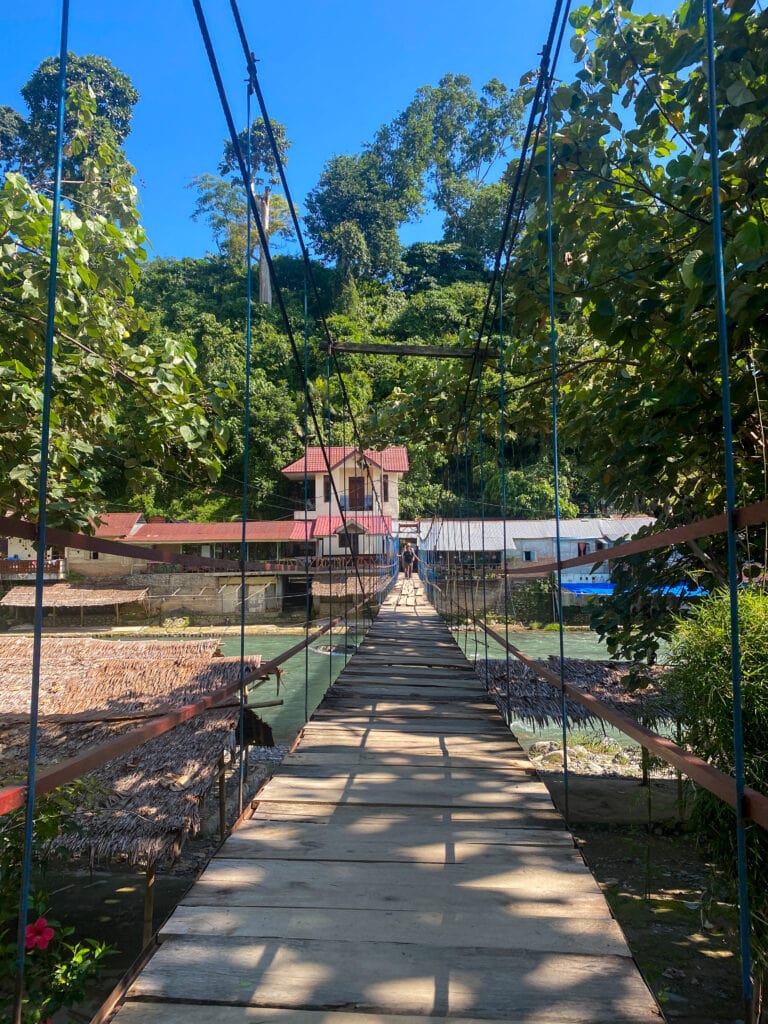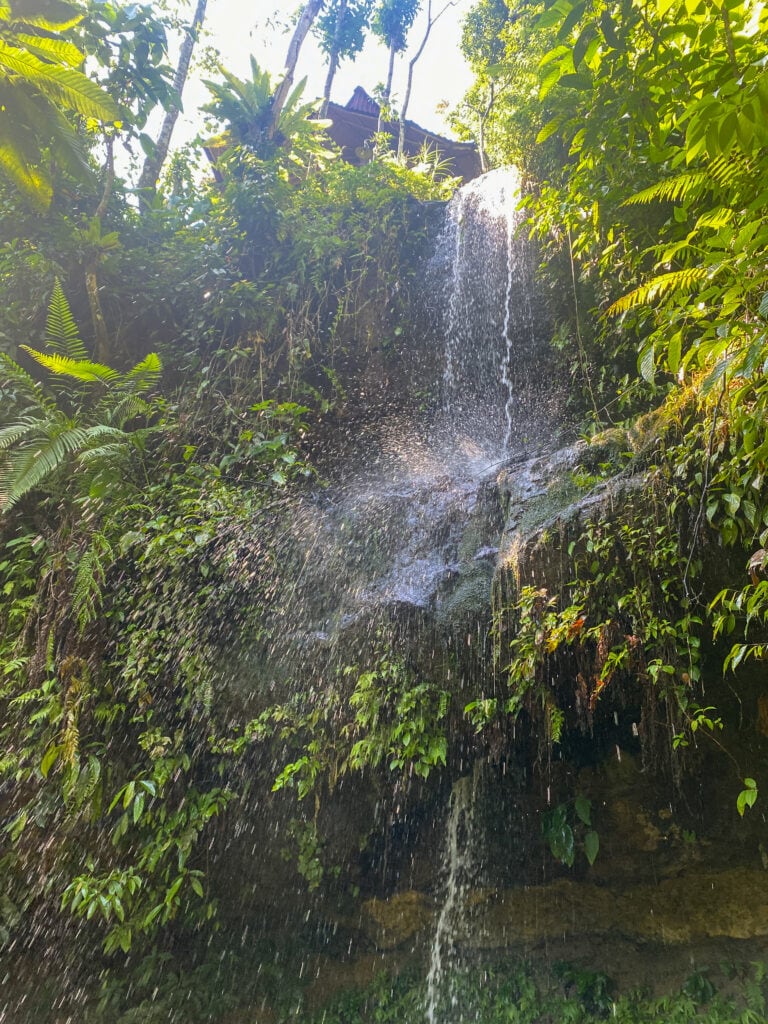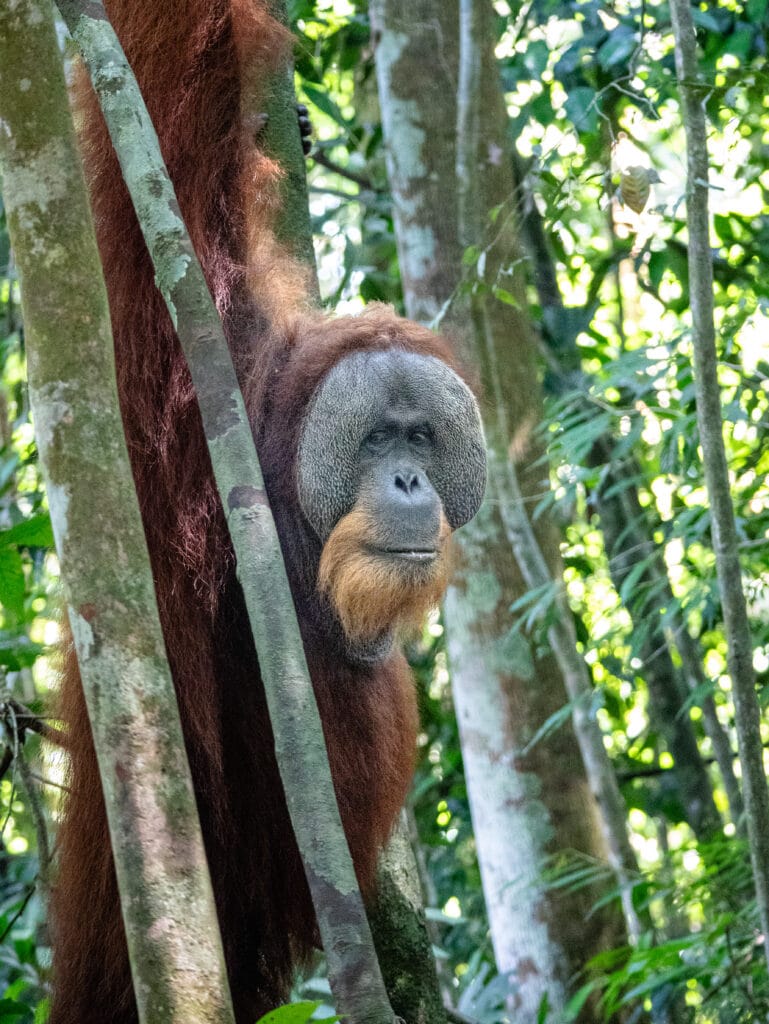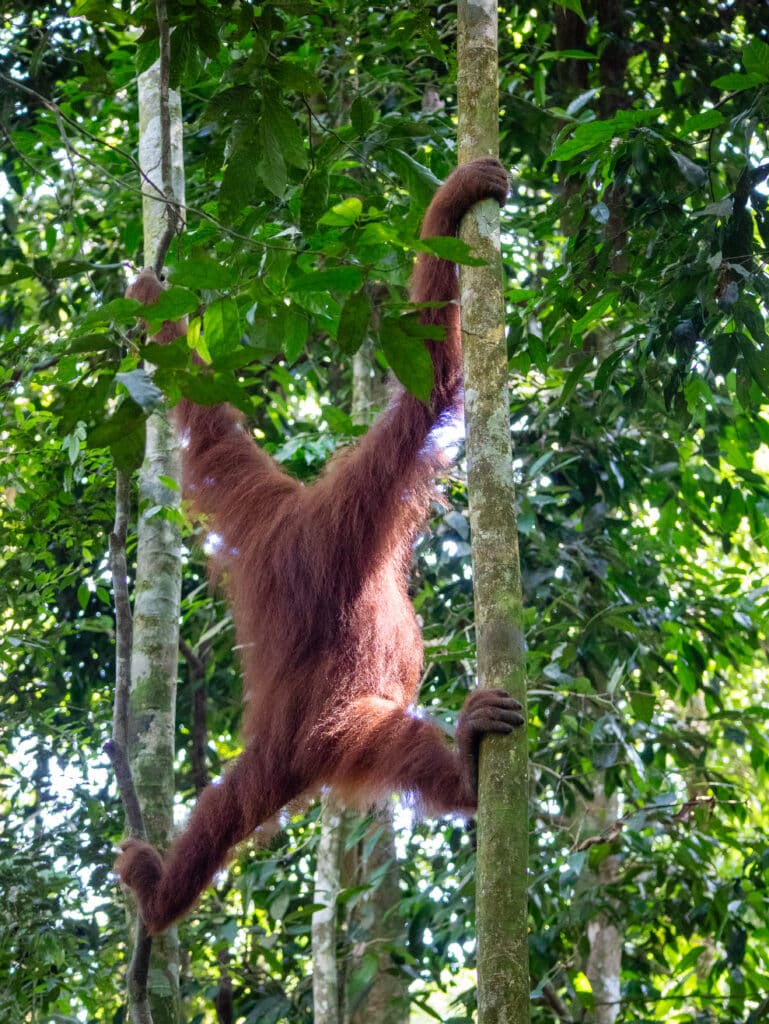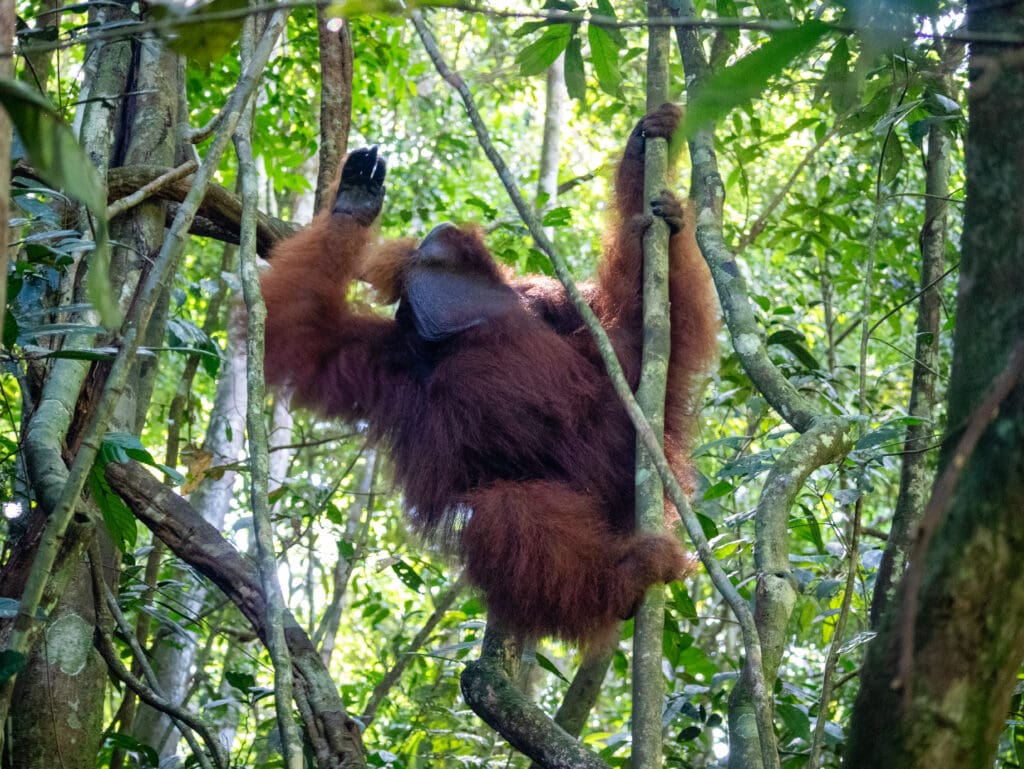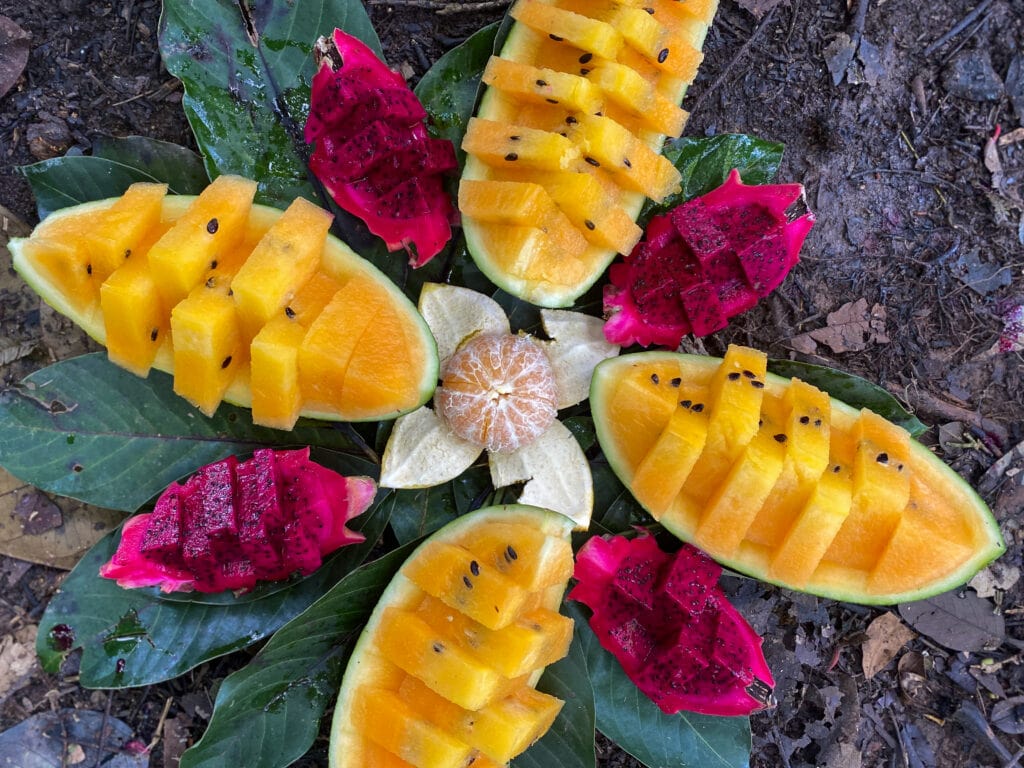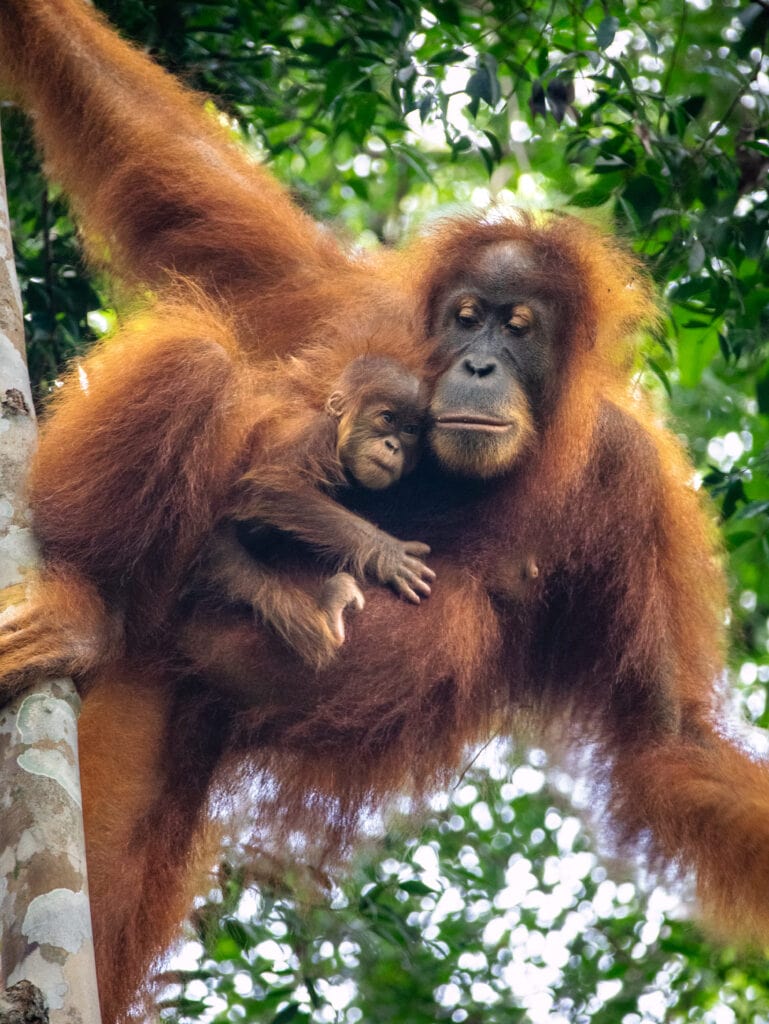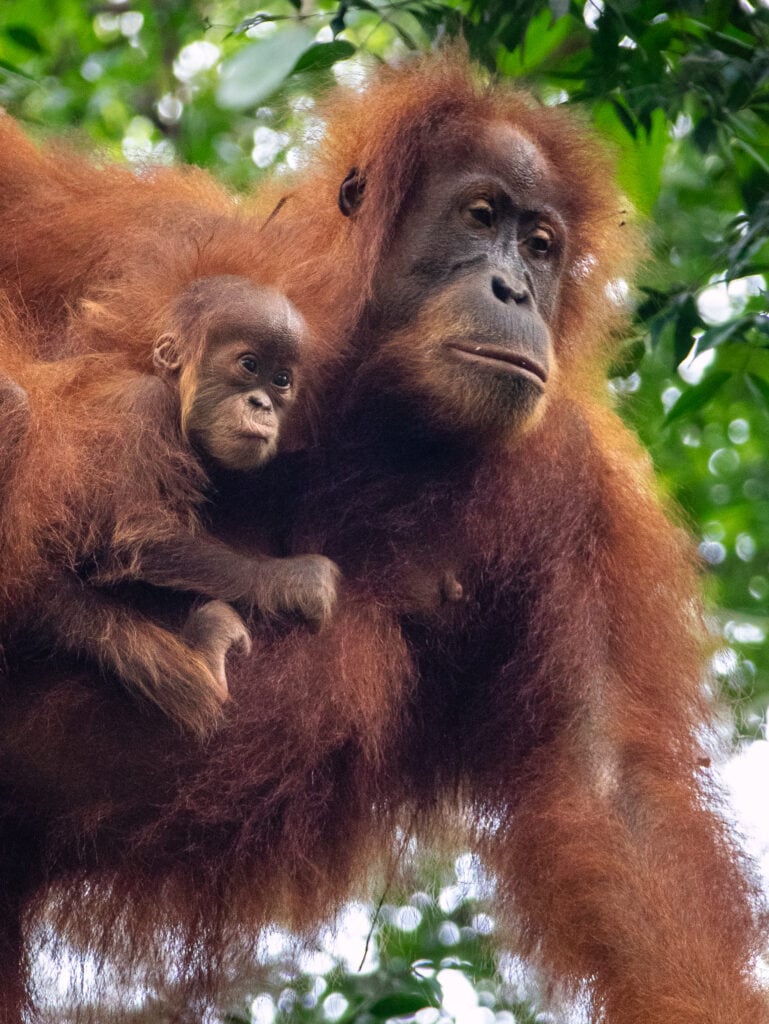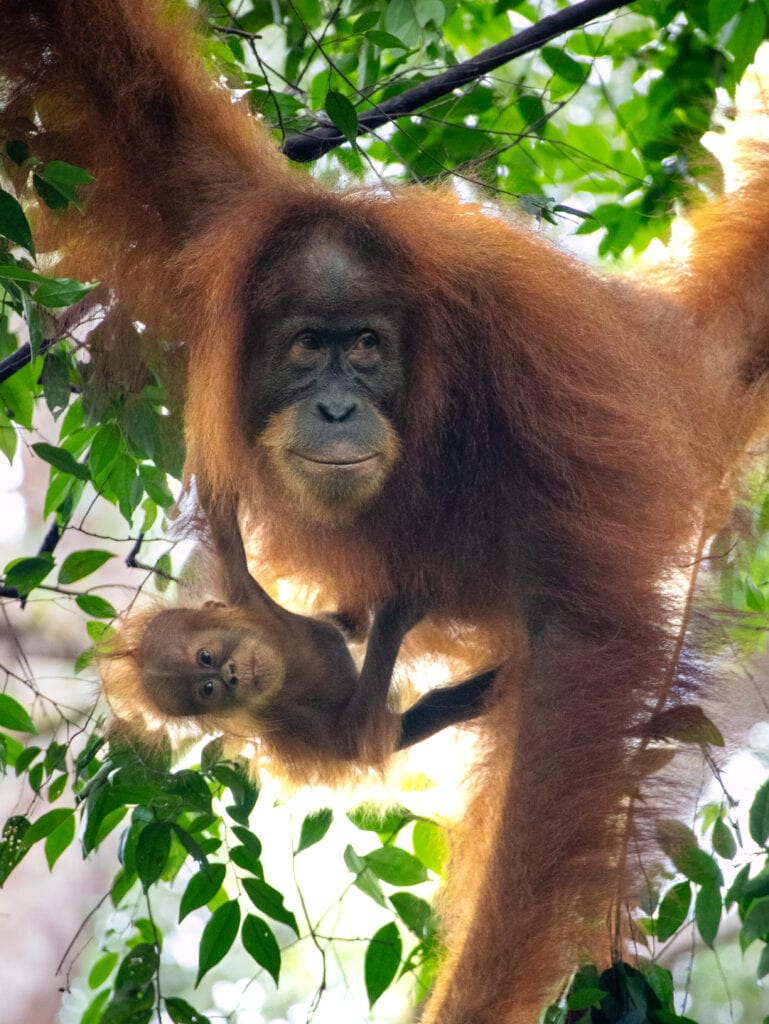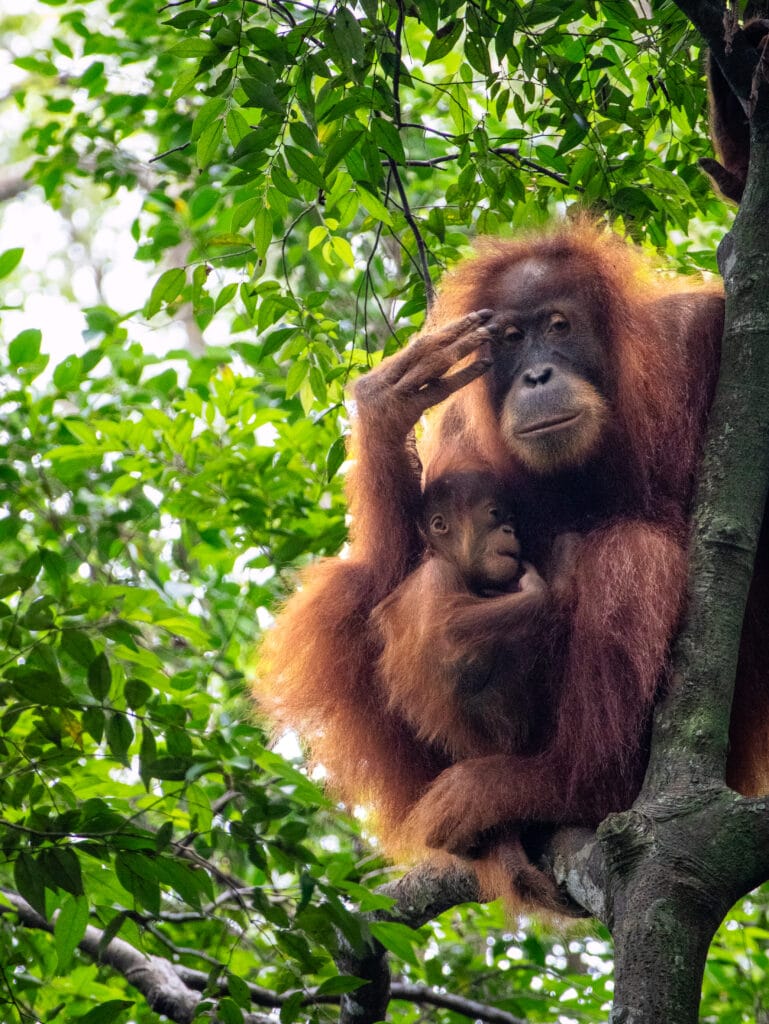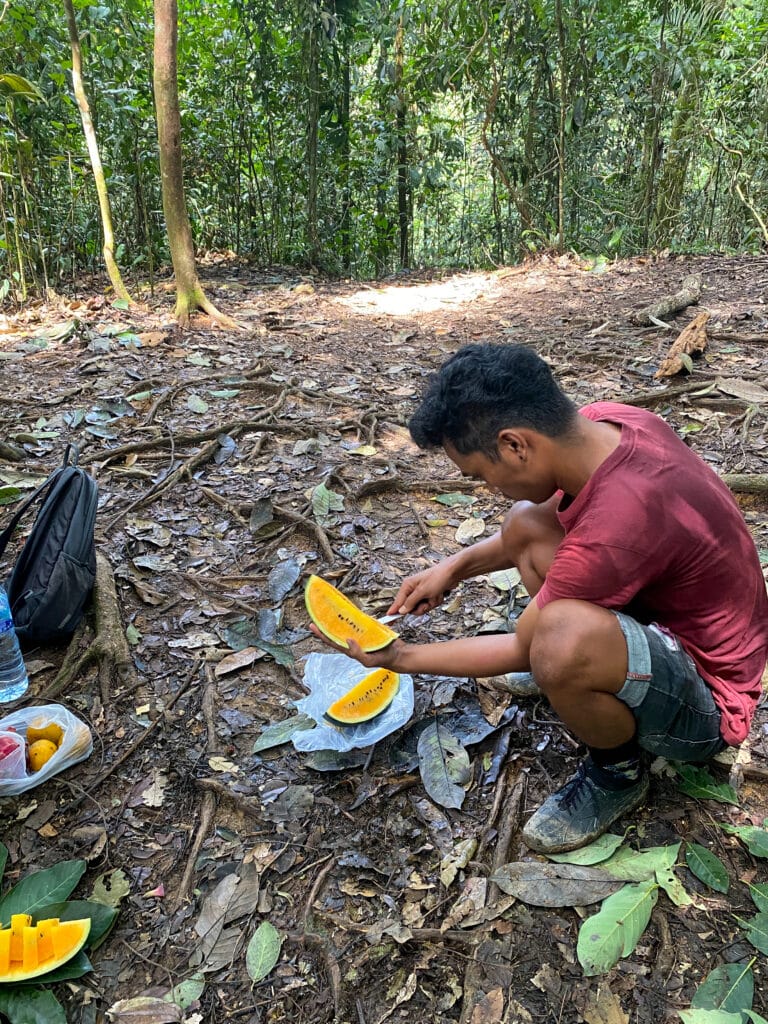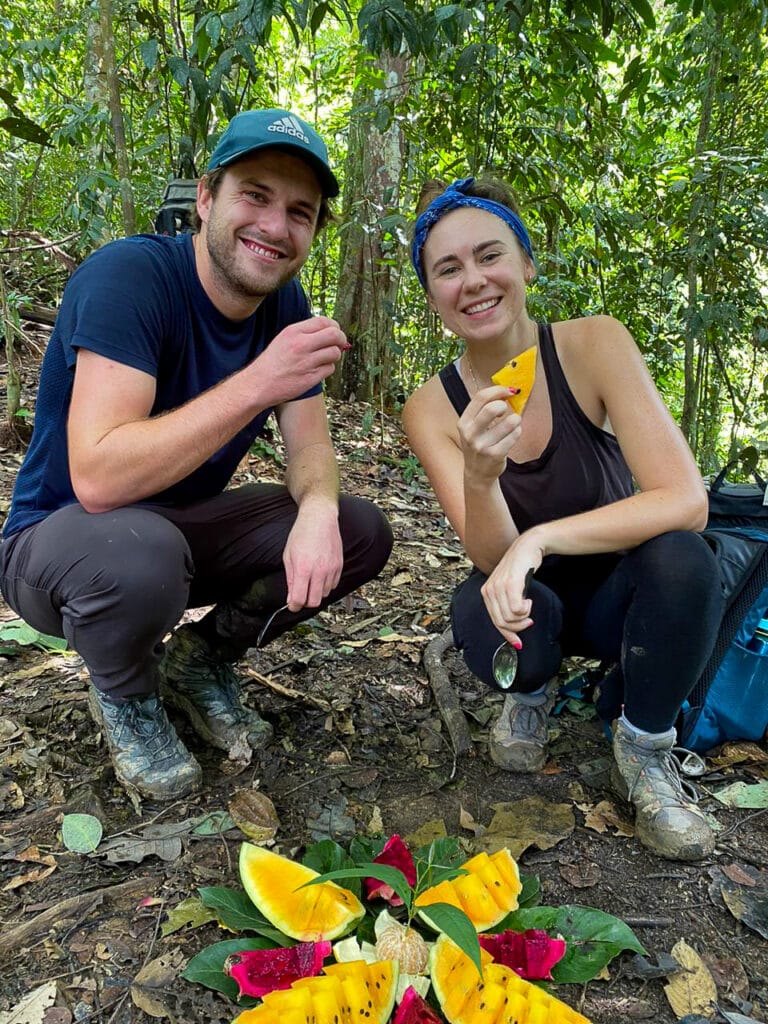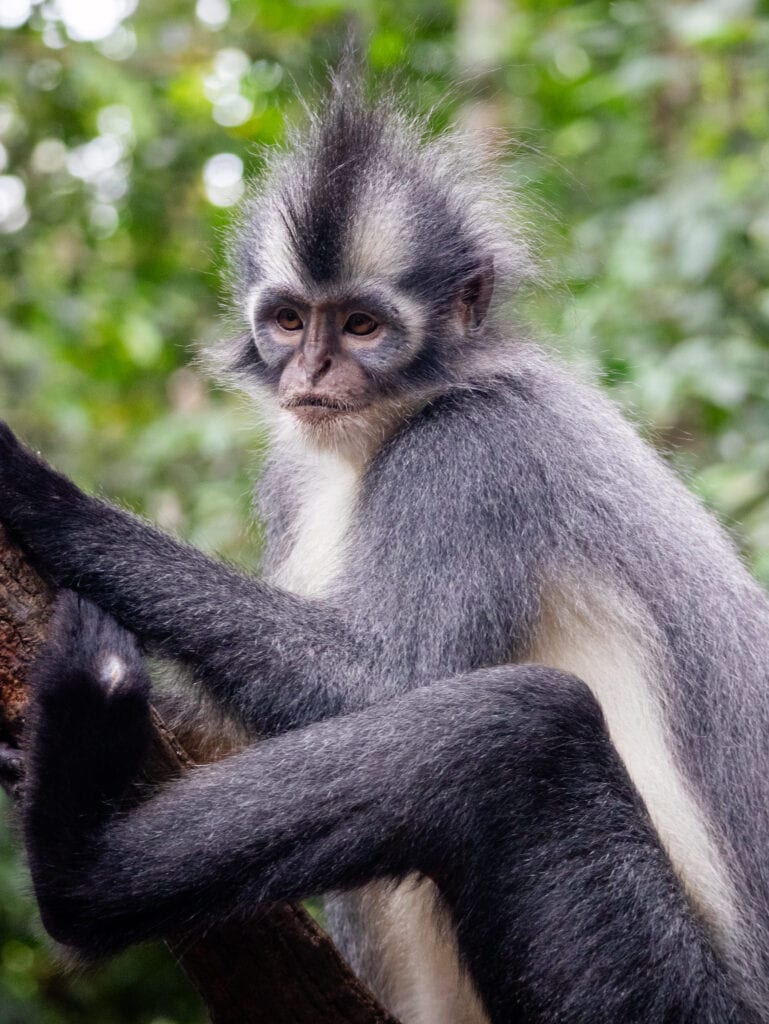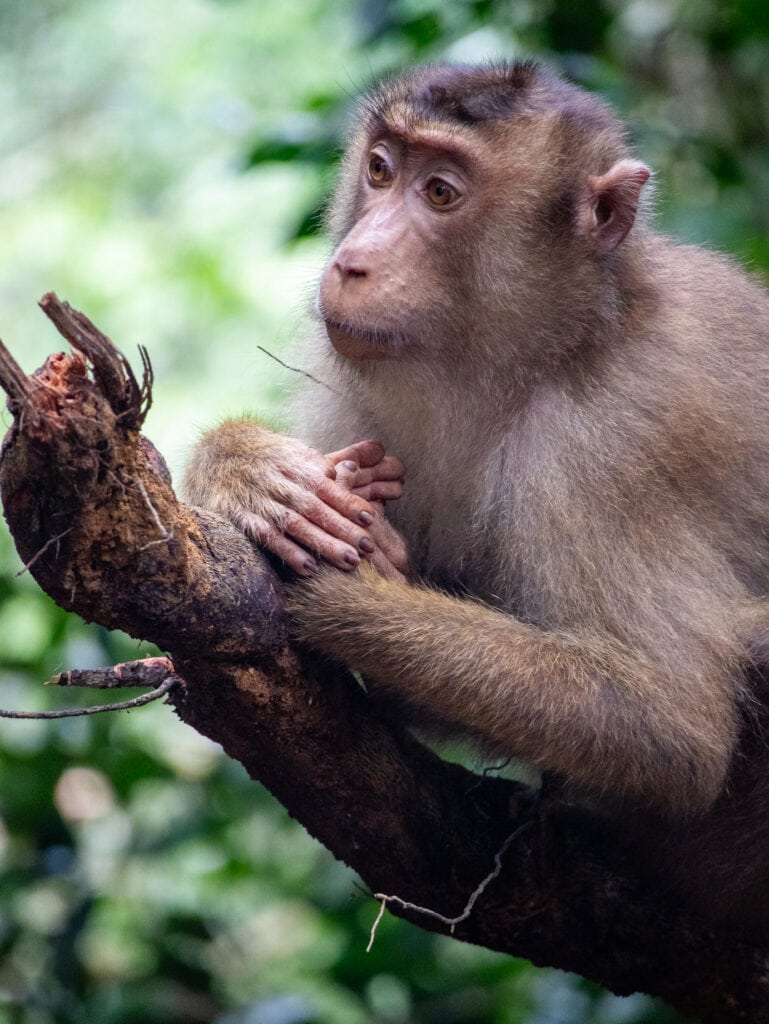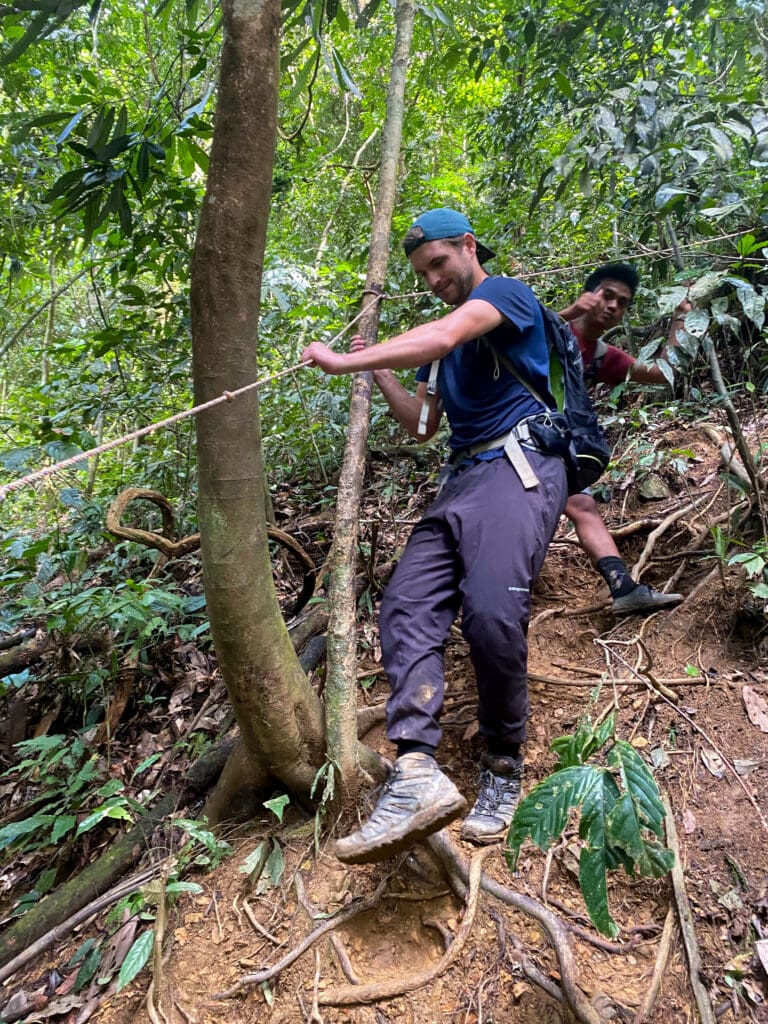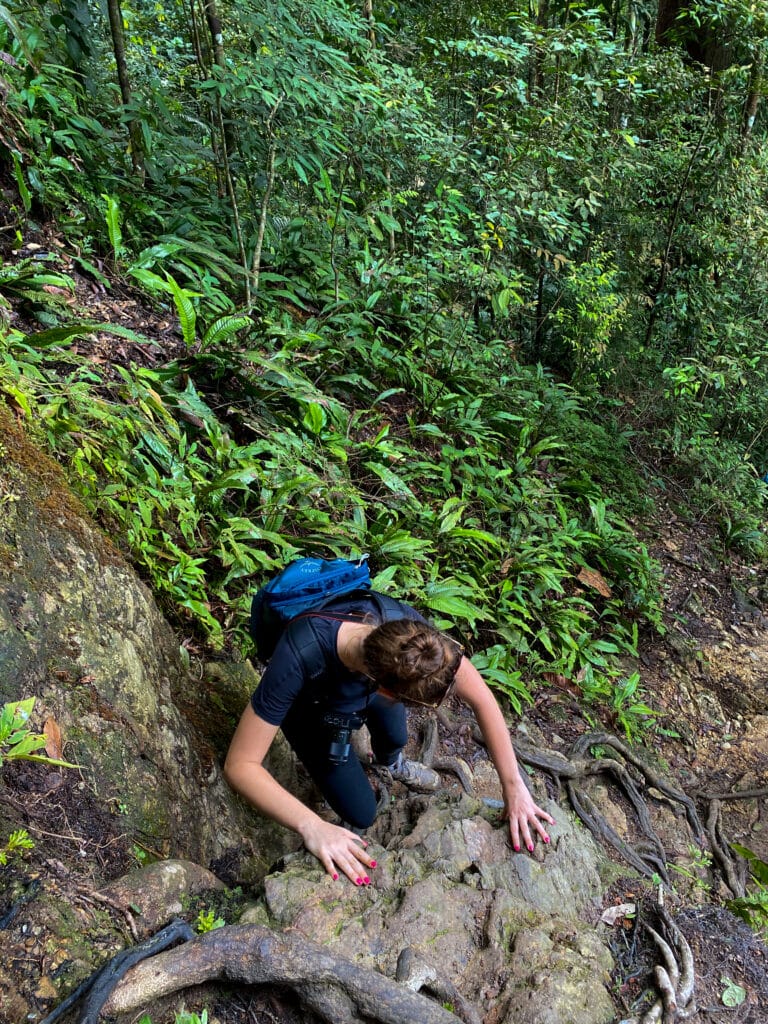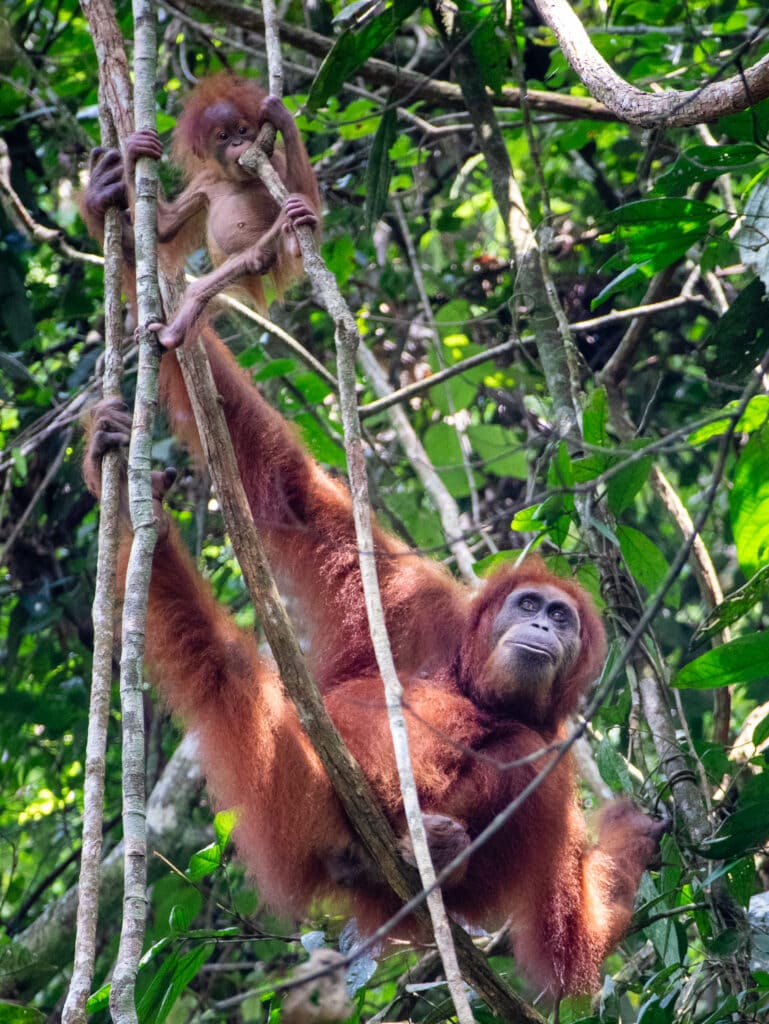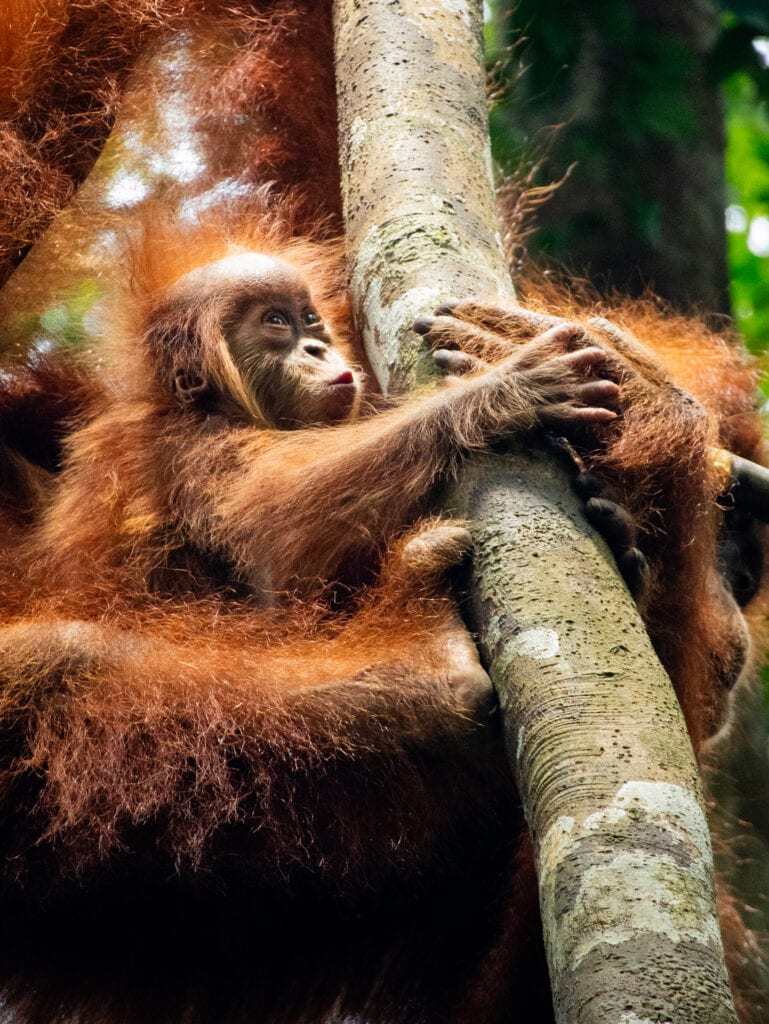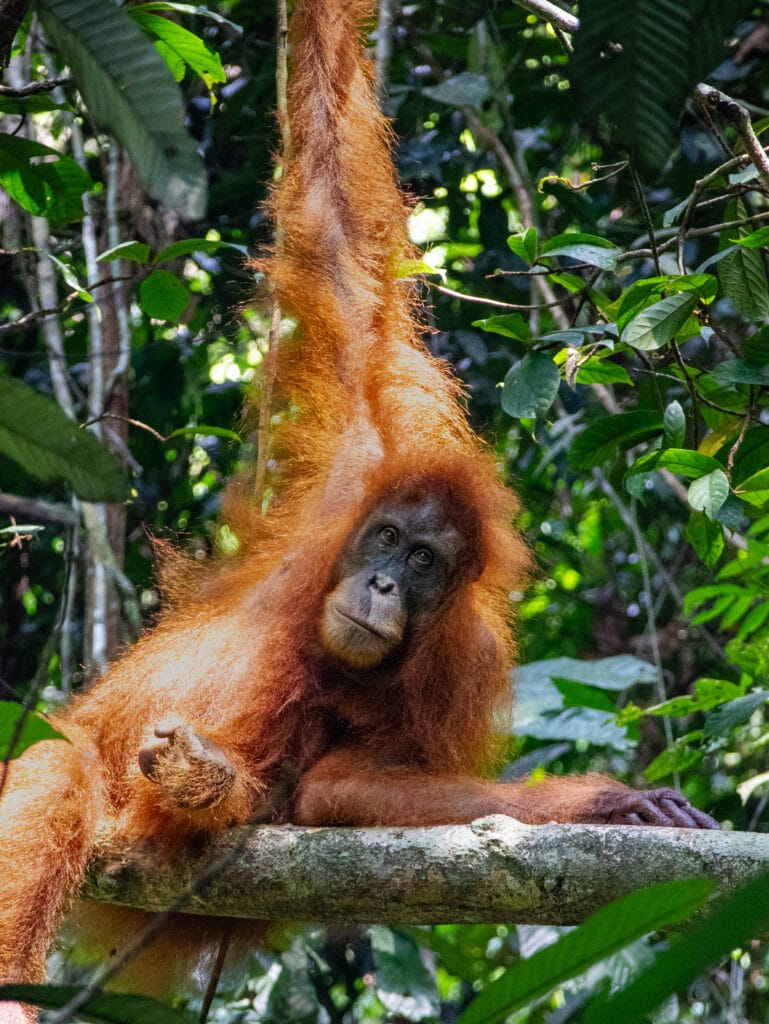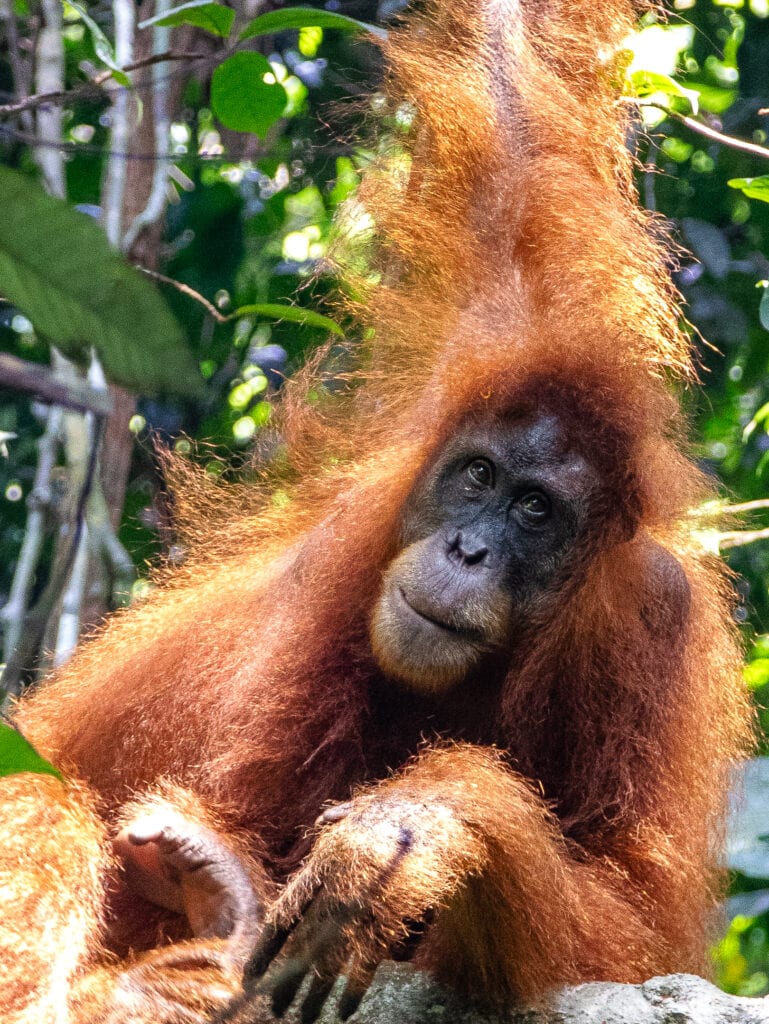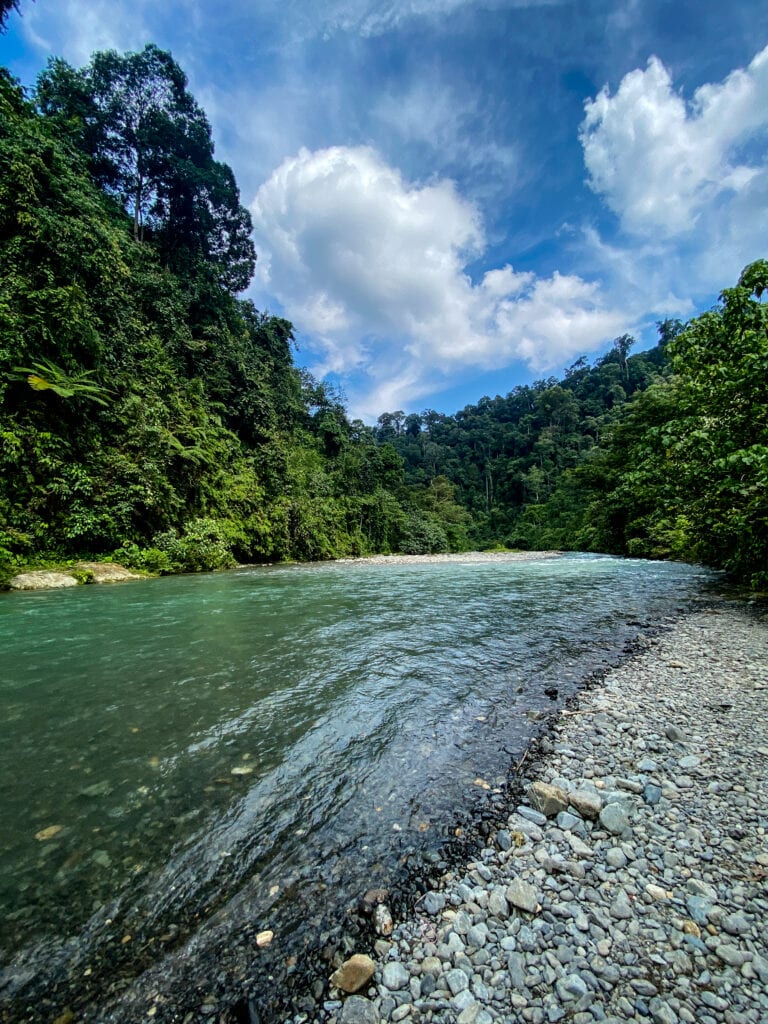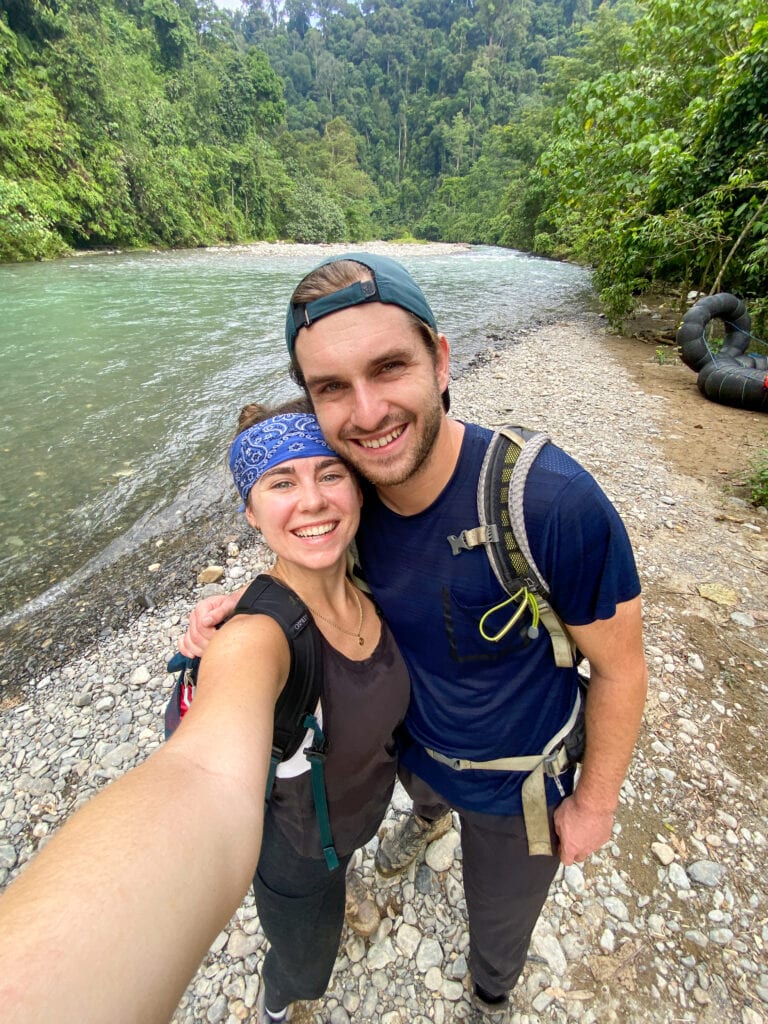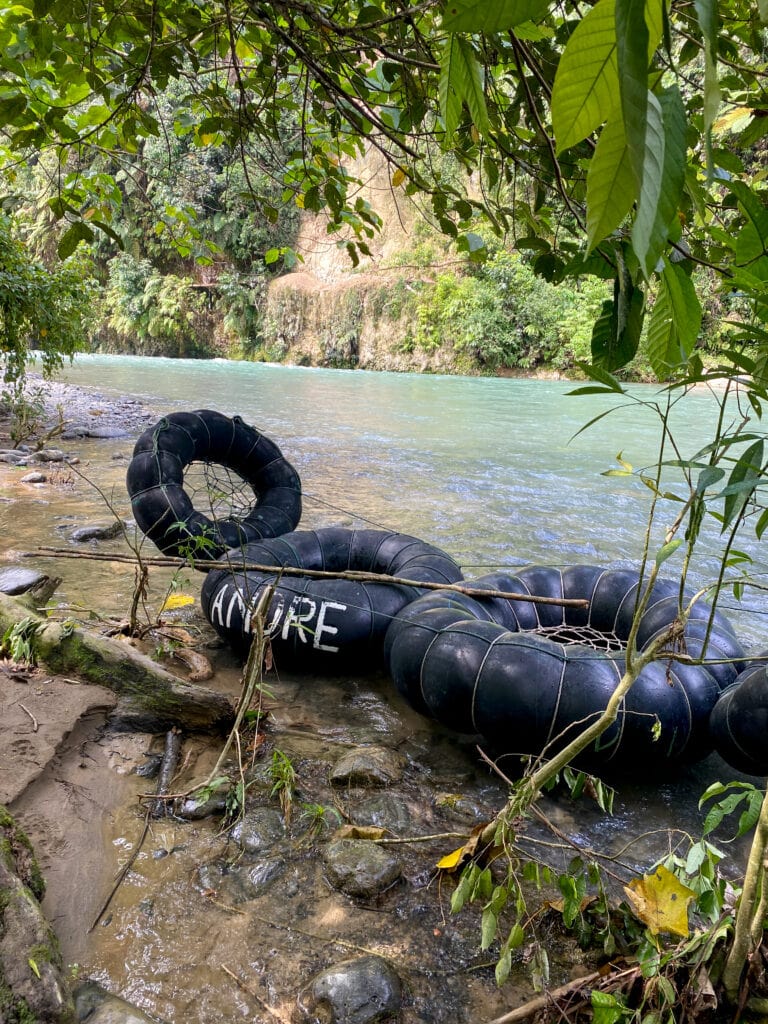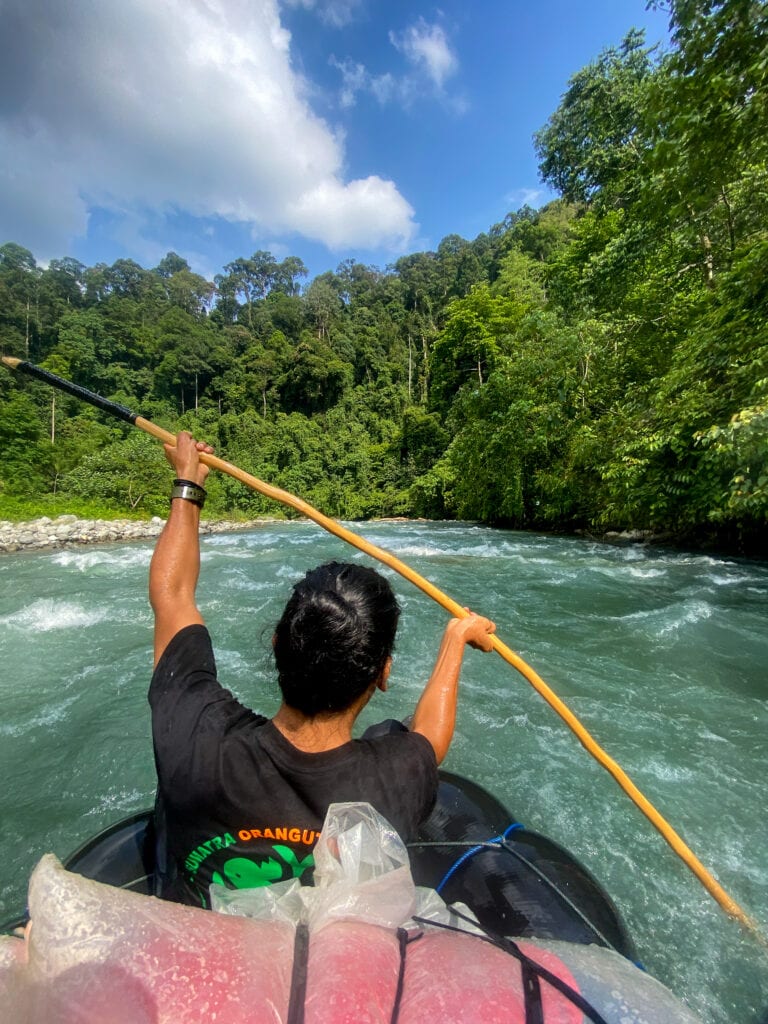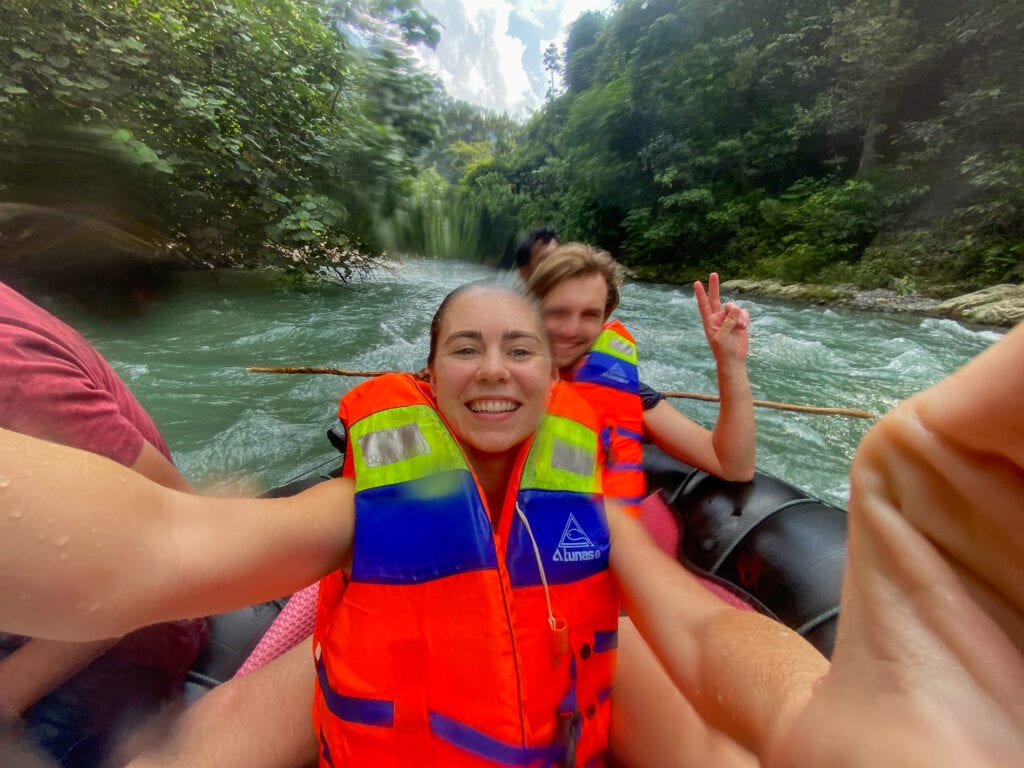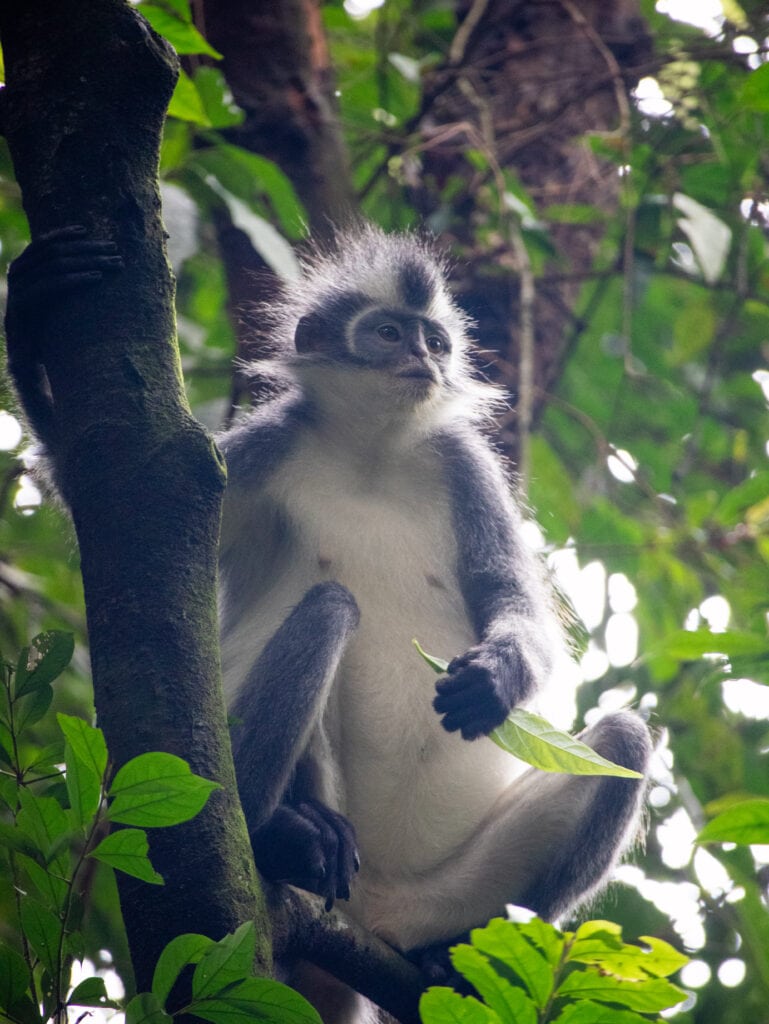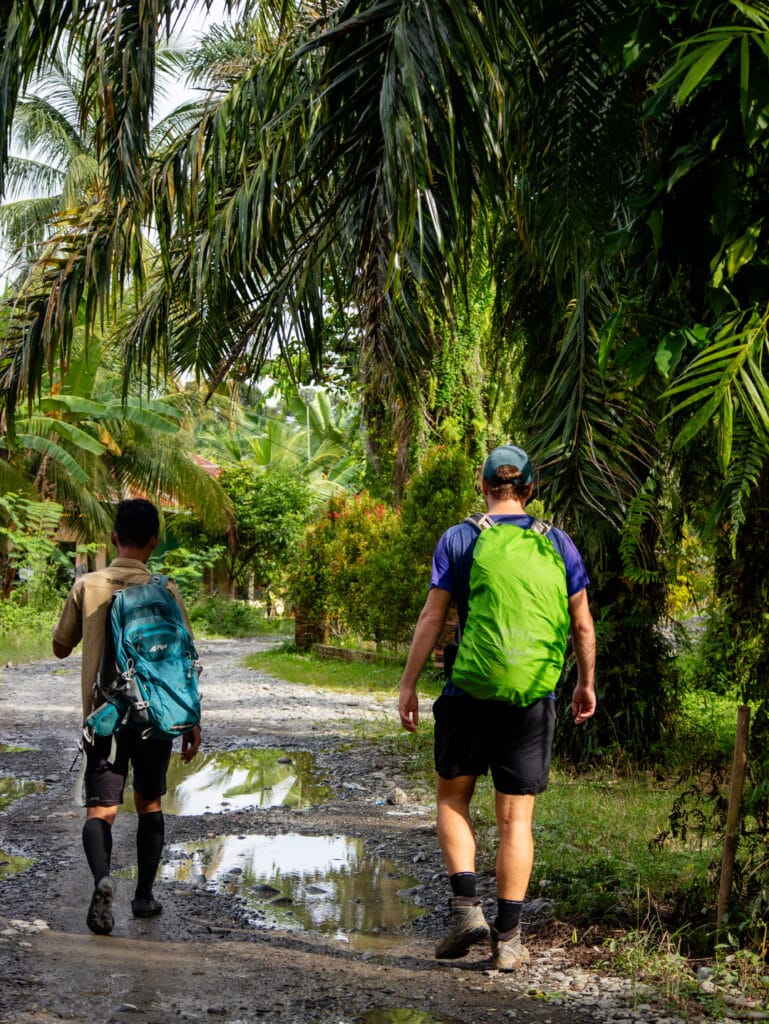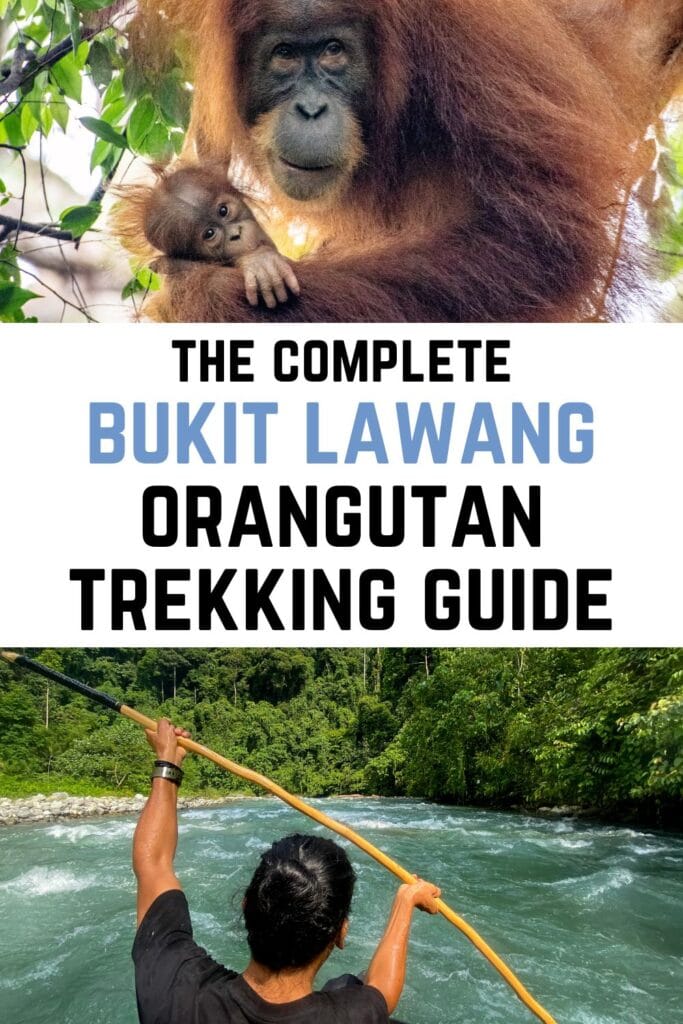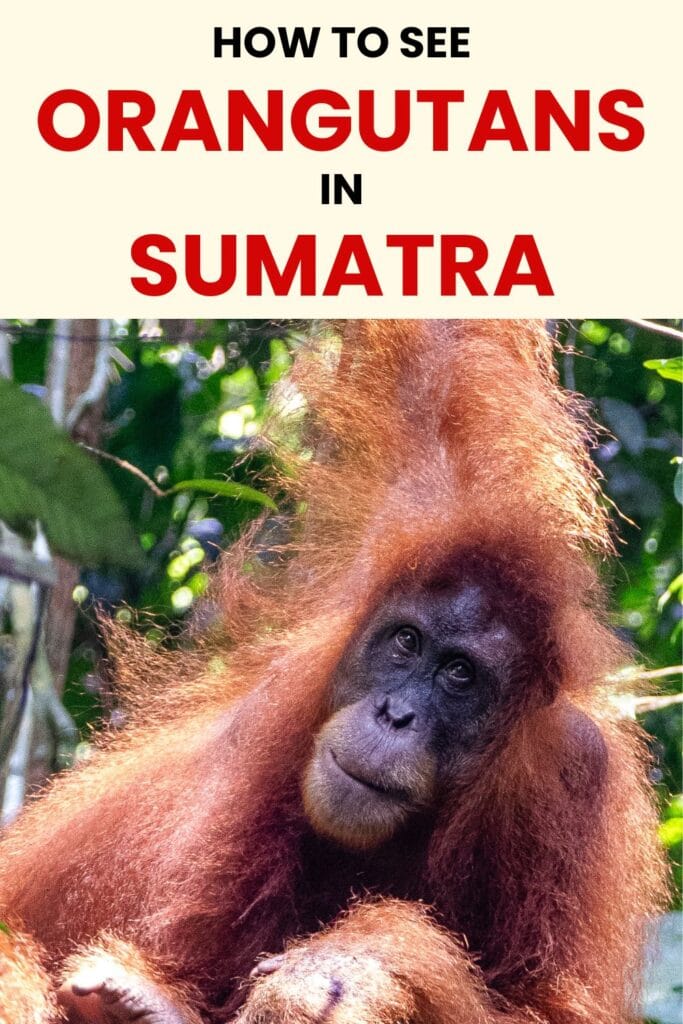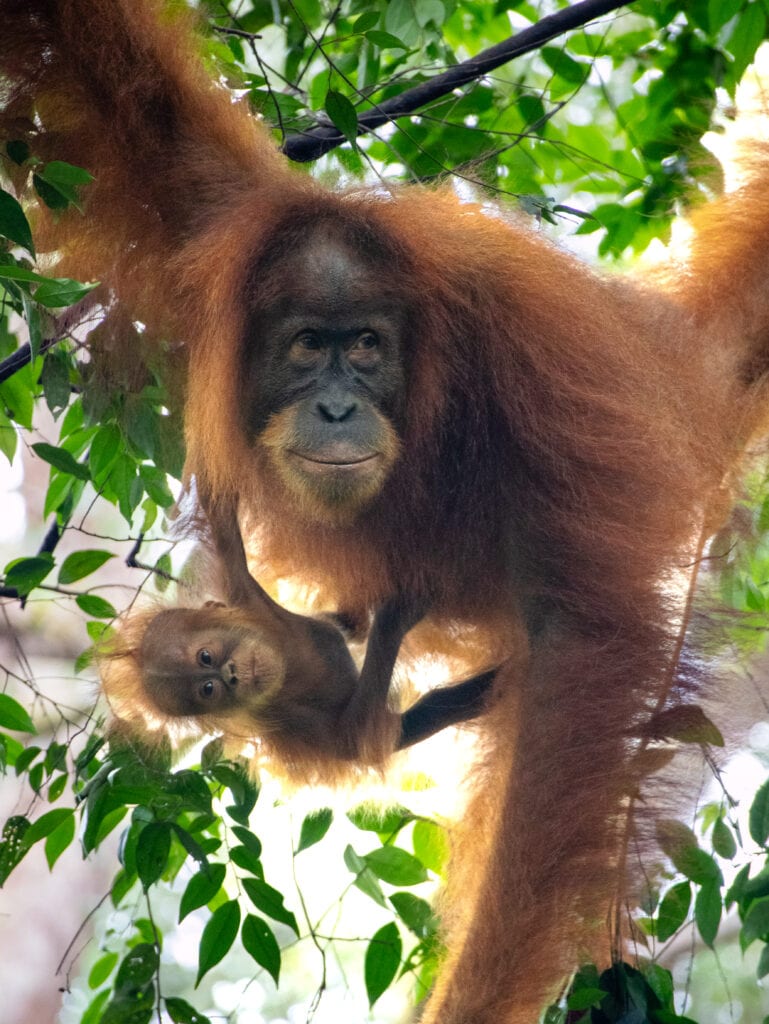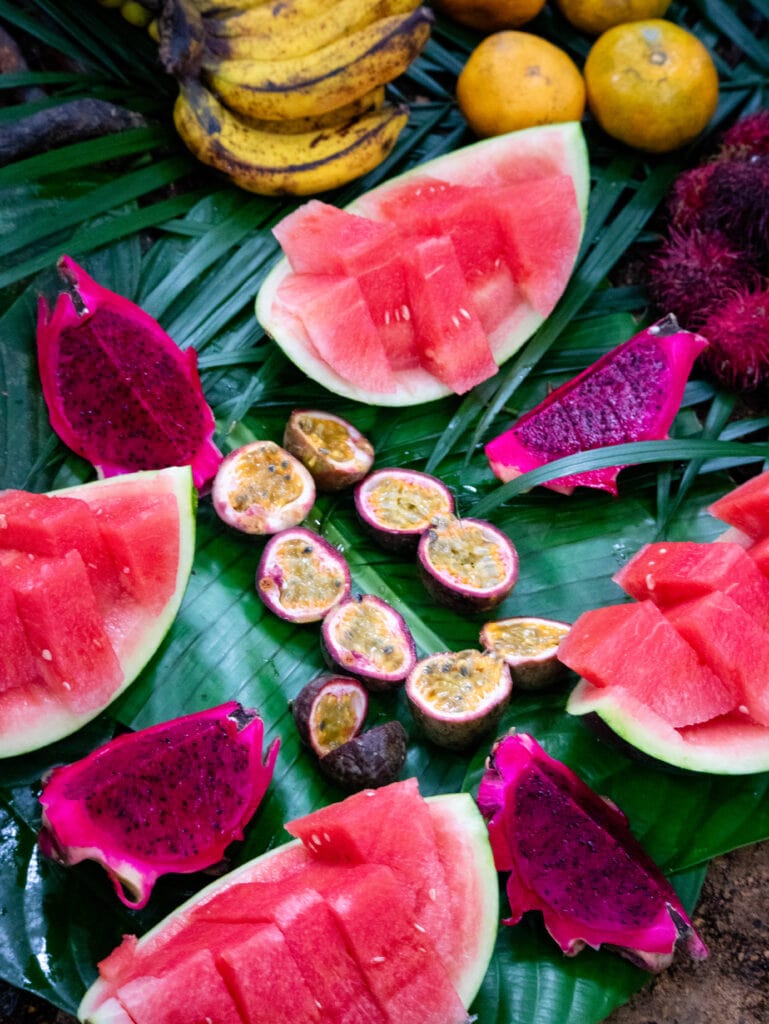Bukit Lawang Orangutan Trekking: Your Complete Ethical Guide
There are only two places left in the world where you can see wild orangutans: Sumatra and Borneo. I was lucky enough to visit Sumatra, an island in northern Indonesia, for a Bukit Lawang orangutan trekking trip.
During our treks, we saw a total of 10 wild orangutans. I was mesmerized. I never wanted to look away, as the orange hairy creatures swung through the trees, or cuddled their babies, or stared directly into my camera lens with the most deeply human-like expressions. It was a dream come true.
If you are planning a Bukit Lawang orangutan trekking trip – and particularly if you want to ensure you choose an ethical trekking company – keep reading!
Bukit Lawang Orangutan Trekking: Essential Information
Bukit Lawang is a village in Sumatra, Indonesia. It is the most popular place in Sumatra for tourists to visit, as it is the jumping-off place for jungle treks to see orangutans and other wildlife.
That’s because Bukit Lawang sits on the edge of Gunung Leuser National Park, a UNESCO world heritage site and home to an estimated 5,000 of the 6,600 remaining Sumatran orangutans.
There is, of course, no guarantee that you will see an orangutan while visiting Bukit Lawang. But let’s just say it would be extremely unlikely for you to not see one, especially if you are spending more than one day trekking.
Dan and I spent 5 days in Bukit Lawang, with the goal to see as many orangutans as possible – and be as ethical as possible while doing so. Below I’m sharing my complete guide to how you can also trek with orangutans in Sumatra, like we did.
How to Get to Bukit Lawang
If you want to see wild orangutans, then your first step is to get to Bukit Lawang. The village is pretty remote but it is surprisingly easy to get here, once you know the steps!
Fly to Medan, Sumatra
First, you need to get to Sumatra, and specifically the capital city of Medan in north Sumatra. You will do so by flying into Kualanamu International Airport (KNO).
I recommend searching for cheap flights on Skyscanner. There are regular flights from Denpasar Airport in Bali to Medan. International hubs of Kuala Lumpur and Singapore Changi Airport are both within a 1-hour flight of Medan, too, so you have plenty of options.
Dan and I were coming from Tokyo, Japan, and we found a good flight deal on AirAsia for a redeye with a layover in Kuala Lumpur. I’d never flown with AirAsia before and for a budget airline they were pretty good!
TIP | Be sure to get cash out at the ATM in the airport arrivals hall. There are NO ATMs in Bukit Lawang!!
Transport to Bukit Lawang
Once in Medan, you need to get to Bukit Lawang, and it’s a longer journey than you might expect.
On a good day, it takes about 3 hours to drive directly from Medan to Bukit Lawang. However, traffic is a nightmare so it regularly takes 4 to 4.5 hours in reality (especially in the afternoon and evening).
How to get from Medan to Bukit Lawang:
- Private car: ~750,000 IDR / ~$50 USD for the whole car. This is the easiest and most common option. We arranged it ahead of time through our accommodation and honestly for us it was well worth the price.
- Shared car: ~150,000 IDR / ~$10 USD per person. Sometimes if many people are going to Bukit Lawang at the same time, a “tourist bus” or shared car can be arranged. Inquire about this with your accommodation. When we visited, this unfortunately wasn’t available.
- Public bus: It can take up to 8 hours with 3 different transfers, but backpackers on a budget may prefer going by public transport. First, take the orange ALS bus from the airport to Binjai City (departs every 30 minutes, 40,000 IDR / $2.63USD). Then, take a tuktuk from Binjai station to Tanah Lepang station or Binjai Supermall (5,000 IDR / $0.33 USD). Then, take any bus going to Bukit Lawang (departs every 30 minutes until last bus at about 4pm, 30,000 IDR / $2 USD).
As you can see, it’s a long journey from wherever you are in the world to reach remote little Bukit Lawang. Orangutan treks all leave at 9am, so I recommend giving yourself a whole day of your itinerary to reach Bukit Lawang and start your trekking the following day.
Where to Stay in Bukit Lawang
There is no shortage of accommodation in Bukit Lawang, but I do recommend choosing your accommodation wisely. This is because your accommodation will most likely be providing all your meals during your stay, as well as arranging your trekking tours and other activities.
That’s right, accommodation goes hand-in-hand with trekking here in Bukit Lawang!
I did a lot of research and ultimately we decided to stay at Sumatra Orangutan Discovery Villa.
I am sooooo glad that we chose them and I will go into more detail on why below. But first, I want to touch on why it’s important to stay somewhere that supports ethical orangutan trekking.
More ethical orangutan trekking accommodations in Bukit Lawang:
(Please note that my only personal recommendation is to stay at Sumatra Orangutan Discovery. However, they are a small operation so I wanted to provide some other options in case they are full during the dates of your visit!)
Ethical Orangutan Trekking: 4 Reasons Why This Matters
But why does an ethical orangutan trek even matter?
Let’s get into this because it’s SO important to understand this situation before you plan your trip to Sumatra to see orangutans.
1. Sumatran Orangutans Are Critically Endangered
Sadly, Sumatran orangutans are critically endangered.
In fact, according to WWF, there has been a sharp population decline and currently there are only about 7,500 Sumatran orangutans left in the wild.
If that trend continues, then orangutans could be extinct within 10 years.
That is so crazy to me to think that if our world doesn’t change FAST, then I will have to visit Indonesia again in the next decade if I ever want to see a wild orangutan again (I mean, yes I’d love to go back to Indonesia but that’s still downright depressing!).
2. Palm Oil is Killing Orangutans
So why are orangutans so endangered? Palm oil is the #1 reason orangutans are dying.
Orangutans are rapidly losing their habitat due to deforestation – both legal and illegal. Across Sumatra, natural rainforest is getting demolished to make way for unsustainable palm oil plantations.
You’ll see this for yourself as you drive from Medan to Bukit Lawang. The endless, perfectly straight rows of identical palm trees. It’s eerie, and disturbing.
Today, approximately 50% of orangutans can be found outside protected areas, and living within plantations and other dangerous areas. They are losing their homes and dying gruesome deaths, so that we can have shampoo, toothpaste, vegetable oil, candy, baby food, you name it.
According to the Orangutan Foundation, about 50% of household products in the West contain palm oil. And “sustainable” palm oil is a misnomer – there’s not really any such thing. Read their resource to learn more about what products contain palm oil. Join me and boycott palm oil to save the orangutans!
3. Gunung Leuser National Park is Being Deforested
Thank goodness for Gunung Leuser National Park.
This national park and biosphere is a UNESCO world heritage site. In addition to endangered orangutans, it is also home to elephants, tigers, and rhinos.
Unfortunately, despite being “protected” land, Gunung Leuser is still at great risk.
It’s estimated that Gunung Leuser has lost 1/5 of its land area to illegal logging over the past 5 years. If that continues, the rainforest will be entirely destroyed within 20 years.
During our visit, we learned that new cement posts have been erected around the park, so that people cannot encroach their private land, farms, and plantations into the park.
4. But Wait… Orangutan Trekking Can Help!
Now that you’ve learned the dangers orangutans are facing in their homeland, you can understand why ethical trekking is so important.
I do want to add another reason we should support ethical treks, beyond the obvious of not harming orangutans: socioeconomic impact!
Many people in Sumatra are impoverished, and palm oil plantations offer jobs and an accessible livelihood. Let’s not demonize this. These people are trying to put food on the table for their families, and palm oil is right there.
You know what else is right there? Orangutan trekking tourism.
Tourism is an alternative income for many locals in Bukit Lawang, who would otherwise be working on destructive palm oil plantations. As tourists, by demanding ethical treatment, we can help not only the orangutans but the incredible people of Sumatra.
That’s why it’s SO IMPORTANT to not only choose an ethical Bukit Lawang orangutan trekking company like Sumatra Orangutan Discovery, but to also SPEAK UP if you observe any unethical behaviors in the jungle. If we create a demand for ethical trekking options, this demand will be met.
Ethical Orangutan Trekking Rules
How can you tell if a company is ethical or not? Well, the Indonesian Tourist Guides Association (ITGA) created a list of rules to ensure ethical orangutan encounters.
Rules for ethical orangutan trekking:
- Keep a distance of 10m or greater from orangutans.
- No feeding.
- Leave no trace – including organic waste.
- No luring or calling for the orangutans.
- Do not take any plant matter from the jungle.
- Do not go trekking if you are sick – this can pass to the orangutans, who share 97% of our DNA.
- No flash photography.
I think the MAJOR rule you have to watch out for is feeding. Sadly, I observed some (other groups’) guides feeding orangutans bananas, pineapple, and sugarcane during our trek.
In some cases, they really tried to hide this action from tourists – hiking further off the trail and planting the fruit. Obviously, though, the orangutan who then grabbed the perfectly, evenly cut sugarcane didn’t make that himself! Thankfully, none of our guides did this.
Side note, you should look for a guide that is certified through ITGA. The Sumatra Orangutan Discovery guides are certified.
What to Do if Your Guide Breaks These Rules
If your guide breaks one of the rules above – namely, feeding the orangutans – I encourage you to speak out.
A lot of guides feel pressured to “deliver.” They know you paid a lot to come to Sumatra, and have high hopes of seeing an orangutan. Sometimes, tourists even get angry or write bad reviews if they don’t see an orangutan.
As a result, some guides have stooped to feeding the orangutans to lure them closer. I even saw a few guides give their tourists fruit, and encourage them to feed monkeys!!
I know it’s difficult to speak up, but we MUST. We’ll only see change if we let the guides know that we as tourists prioritize ethics over encounters. This is how we will save the orangutans!
During our first day’s trek, I actually observed two fellow tourists arguing with their guide because they’d seen him sneak off the trail to leave sugarcane for an orangutan that was in the area.
Well, this couple went off, telling their guide thy were deeply disappointed in him. It sounded like a very difficult conversation, but I’m sure it left a mark on that guide and hopefully showed him that (some) tourists value the wellbeing of the orangutan over getting more photos. Maybe he will change his actions next time.
I was proud of those two strangers, and I would encourage you to do the same if you observe any unethical behavior. Together, we can be the change!
Ethical Bukit Lawang Orangutan Trekking: Why We Chose Sumatra Orangutan Discovery
Obviously, one reason we chose Sumatra Orangutan Discovery was because they focus on ethical trekking tours.
I can attest that they follow through on their promise (based on my observations in the jungle, I don’t think the same can be said of every company in Bukit Lawang that calls themselves “ethical”!).
There were a lot of other reasons we were happy we stayed with and booked our trekking with them, though. Actually, this was one of the very best places we’ve stayed across nearly 2 years of full time travel in Asia and Latin America!
Why did we LOVE Sumatra Orangutan Discovery?
- The people: Ellie and Tyson and their entire team are just awesome, kind, good vibes humans. We loved getting to know everyone and the nightly guitar jams as well!
- Comfort: Literally anywhere you stay in Bukit Lawang is going to be “rustic,” and knowing that, I was honestly surprised at how comfortable our room was. The bed was sooo comfy, the room impeccably clean, the shower wasn’t heated but this was actually fine, the decor was tasteful, and the lack of AC (I was worried about this) ended up being totally fine with 2 fans and plenty of air flow.
- The food: Let’s just say Tyson is an incredible cook and the food (and coffee) here blew my expectations out of the water.
- They can accommodate dietary restrictions: I have celiac disease and have to eat gluten free, and they catered for me SO WELL. They can also do vegan and vegetarian. I wrote a whole blog post about gluten free Sumatra, so check that out if you’re in the same boat.
- The communication / organization: Honestly I was so impressed at Ellie’s communication. It was so easy to organize everything from our private transport to my gluten free food and more.
- Value for money: Our room (the nicest one with 2 beds, private bathroom, and a HUGE balcony) was only $26 USD/night!!! Food was also incredibly reasonably priced. The treks were competitively priced as well. I don’t regret a single cent I spent here.
- The animals: Finally, I have to give a shout out to Baloo and Manis (resident puppy and kitty), the real stars of Sumatra Orangutan Discovery! These guys were soo sweet and I miss excitable Baloo scritches and Manis lap cuddles so much.
Length of Trek
Now, let’s get into the nitty gritty. Starting off, how long of an orangutan trek should you choose?
Overnight Trek
The most popular length is 2 days / 1 night.
This involves sleeping overnight in the jungle, at a basic camp. You carry all your clothes, toiletries, towel etc. in your backpack. Your guide will carry all the food.
The camps are quite basic with tents or small huts, with sleeping bags and yoga mats. There are no toilets (bring your own toilet paper) or running water – plan to “shower” in the river.
You can also do longer treks, with 3-, 4-, 5-day and more options available.
Day Trek
Another option is to do a full day trek. This starts around 9am and returns around 4:30pm. You spend the day trekking through Gunung Leuser, then raft back to Bukit Lawang along the river (this is an experience in and of itself – more details below!).
For full day treks, you’ll return to your accommodation in time for dinner and a shower.
Overnight vs Full Day Orangutan Trekking
Dan and I had 3 full days in Bukit Lawang, and instead of booking an overnight trek we actually ended up doing two full-day treks, followed by a day chilling in Bukit Lawang.
On our first day’s trek we only saw one orangutan. On our second day, the weather was sunnier and we ended up seeing nine!!
The main reason we chose to do this, instead of sleeping overnight in the jungle, was because I have to eat gluten free and it was going to be challenging to get safe gluten free food in the jungle. Read more details in my gluten free Sumatra guide.
A secondary benefit to day treks is of course that at the end of the day you get an actual toilet, shower, and bed! Not to mention it is more environmentally friendly.
Another reason to consider day treks is that, surprisingly, you are just as likely to see orangutans. It’s true! The majority of orangutan sightings happen closer to Bukit Lawang, in the area where a rehabilitation center used to be located. These orangutans are semi-wild and wild (the offspring from released orangutans), and much more likely to hang out in areas visible to humans.
I met multiple people who went on longer treks and they all said that the vast majority of orangutan sightings they had happened on the first day, close to Bukit Lawang. One friend even did a 5-day trek and he only saw orangutans on day 1!
Pros and Cons
| Overnight trek | Full day trek | |
| Pros | -Experience camping overnight in the jungle -Possibility to see more wildlife like elephants -More immersive experience | -Comfort of sleeping at your accommodation -More suitable for dietary restrictions -Still a high possibility to see semi-wild orangutans that hang out closer to Bukit Lawang -Lighter backpack -Less environmental impact on the jungle |
| Cons | -No toilets, showers, or beds -Not suitable for dietary restrictions -Heavier backpack with more belongings -Greater environmental impact on the jungle | -Don’t get the experience of camping in the jungle -Very unlikely to see other wildlife like elephants |
Cost of Orangutan Trekking in Sumatra
The cost of Bukit Lawang orangutan trekking differs slightly between companies. Below is what you can expect to pay with Sumatra Orangutan Discovery, who we went with.
| Number of people | 1 | 2 | 3-6 |
| 1 day trek | €100 | €65 | €55 |
| 2 day / 1 night trek | €170 | €115 | €90 |
| 3 day / 2 night trek | €340 | €170 | €120 |
| 4 day / 3 night trek | €475 | €240 | €165 |
| 5 day / 4 night trek | €580 | €295 | €200 |
We were allowed to pay via international bank transfer with Wise, which saved us a ton of money (and also the hassle of carrying around a lot of cash). Yay! I can’t guarantee that other trekking companies will let you do the same, though.
What’s The Food Like?
The food is basic but good!
For the full-day trek, you can expect one snack break with lots of tropical fruits. For lunch, you will have nasi goreng which is an Indonesian fried rice dish, usually served with prawn chips and a hard boiled egg.
Because I’m gluten free, I got a special nasi goreng with no soy sauce or prawn chips. Yum! Be sure to ask in advance if you have dietary restrictions.
For dinner and breakfast on the overnight treks, you can expect basic meals like grilled meats, rice, and vegetables. On longer treks, this will include food that is foraged along the way!
RELATED | Gluten Free Sumatra Indonesia Guide
What to Pack for Sumatra Orangutan Trekking
Now, you may be wondering what you should bring to Sumatra, and what you might need for your trek.
Below is a short packing list that I created based on what we used and/or really wished we’d brought to Sumatra.
Sumatra packing list:
- Cash (there is NO ATM in Bukit Lawang so get this at the Medan airport)
- Deet bug spray wipes (MUST HAVE!!)
- GRAYL filter water bottle
- Reusable water bottle
- Sunscreen
- Camera with a good zoom lens (I used this camera with this lens)
- Dry bag (to keep your camera and phone safe when you raft down the river)
- Long trekking pants or leggings
- Quick dry shirts
- Tall socks (to prevent leeches)
- Hiking boots with goretex (I swear by these Salomon ones – and yes you really need proper hiking boots, not just sneakers)
- Rain coat
- Swimsuit
- Toilet paper
- Medication and toiletries
- Bandana (to wipe your sweat – trust me!)
- Camp shoes (I recommend plastic birkenstock sandals or other slides)
- Kindle paperwhite, cards, and other entertainment
- Anker portable battery (there are not many outlets so we used ours a LOT)
What you bring on your actual trek is going to depend on whether you’re doing a day trek or an overnight trek. If you’re doing an overnight trek, then plan to bring pretty much everything above.
For our day trek, I brought my bandana, 1.5L of water, camera, dry bag, and bug spray. I wore long leggings, hiking boots, a quick-dry t-shirt, and a bandana (to mop up my sweat, lol).
I brought a swimsuit but didn’t actually use it – there was nowhere private to change and my clothes were already soaking wet with sweat so I just wore them during the river rafting on both days!
RELATED | My 35 Best Photos of Sumatra, Indonesia
Our Experience Trekking for Orangutans in Bukit Lawang
Here is a quick run down of how our second day trek went, if you’re wondering what the actual orangutan trekking experience is like!
7:30am – Wake Up in Our Accommodation
Dan and I set our alarms for around 7:30am. We spent the next hour at our accommodation having a slow morning on our balcony, before packing our backpacks for the day.
8:30am – Breakfast
Around 8:30am we descended from our room to the dining area, where we had breakfasts that we’d ordered the previous night.
I typically had a vegetable omelette, coffee, and fruit. The coffee is super delicious and dark!
9am – Begin Trek
At 9am, we’d finished breakfast and gathered with our guide to start the hike! On our first day, we started the trek straight from our accommodation, but on our second day we actually jumped on the back of Tyson and Bagas’ motorbikes.
They took us through Bukit Lawang and down to a bridge before hiking under a waterfall. I was happy that we took this slightly different route. Honestly even though we had to full-day treks, they were each so unique from each other.
10am – Our First (Two!) Orangutans
After trekking through the jungle for about an hour (over tree roots, waterfalls, and mud) we had our first orangutan sighting of the day.
Tyson came running up to us whisper-yelling “it’s the macho man!!”. Not knowing exactly what that meant, Dan and I eagerly followed him through the trees.
We came to a clearing where many other tourists were already gathered. They were observing a huge alpha male orangutan in the trees. This guy was a “flanged male” which means he had huge cheek pads.
These orangutans are much more rare to see and you could tell, because all the guides who are out in the jungle every single day were super excited, too!
But that’s not all… there was a second orangutan in the trees: a small female, following the male. According to Tyson, they had probably mated and now she was following him around. Usually orangutans are solitary creatures.
11am – Fruit Snack Break
After the thrill of our first orangutan sighting of the day, we kept hiking a bit before stopping for a snack break.
Tyson and Bagas carried the fruit in their bags, and then expertly cut it up for us. We had bananas, orange, yellow watermelon, and passionfruit. YUM.
11:30am – Second Orangutan Sighting
It didn’t take long to see another orangutan. After finishing our fruit, we walked for another five minutes or so, before stumbling across a clearing with a small gathering of tourists. Everyone was watching a female orangutan hanging in the trees.
But that’s not all! She had a little baby, probably only a few months old, clinging to her chest.
I was totally captivated. We spent the next 45 minutes observing her as she climbed through the trees, being sure to keep our distance.
12:30pm – Lunch
Then, Tyson and Bagas brought us to our “five star restaurant” – AKA two logs in a clearing, haha.
They said that there shouldn’t be any orangutans around here, but they sat on either side of Dan and I to act as “guards.” I guess this is to prevent any orangutans who like to come steal humans’ lunch in this area!
For lunch, we both had nasi goreng which Tyson had made early that morning, then wrapped in banana leaves and carried in his backpack.
For my part, the gluten free nasi goreng was filling and plain. Dan went a bit crazy with the sambal spice sauce on his, and was sweating out the spice like he’d just swum in a river lol.
1:30pm – Four More Orangutans
After lunch, we kept hiking. Up through hilly tree roots, and down through muddy tree roots. SO MANY TREE ROOTS. We saw a few Thomas Leaf Monekys and Pig Tail Macaques, but no orangutans.
Then came the difficult part – a looong, steep downhill hike where we had to grasp onto a rope to keep from falling!
This part was tough, I’m not gonna lie, and if you have any major knee issues then beware. As we made our way closer to the river, I was feeling sad that the day was nearly over and we hadn’t seen any more orangutans.
Just then, Tyson spotted some orange fur in the trees! He told us to wait where we were, and that the orangutan was coming our way.
Turns out she was… but she wasn’t alone! We ended up seeing a mama orangutan with a baby… accompanied by another mama orangutan with her own baby!! This is super rare, because as I mentioned orangutans are solitary.
According to Tyson, one of the mothers was actually also the mother to the other mother (wow I just said “mother” so many times). Basically, the second mother was probably quite young so she hadn’t completely separated on her own yet. Talk about multigenerational!
3:30pm – River Rafting (+ One More Orangutan)
After observing the magical party of four orangutans, we continued our journey down to the river.
Once at the river, we had some time to eat more fruit and paddle about. The stream is FAST, though, so neither Dan nor I really felt like swimming very much.
Then, it was time for our journey back to Bukit Lawang. Since this was our second day trekking, we knew what to expect, but I’ll tell you that on our first day I was in for a shock.
When I heard “tubing back to the village” I imagined a lazy river tubing experience, floating happily down a placid river. No. That is not what happens. Think of this more like “white water tubing.”
Basically, a few tubes are tied together. As the tourists, we sat in the middle. Our two guides (Tyson and Bagas) sat in a tube at either end, with a big stick. That’s right… no paddles here, folks. Only sticks!
With the power of some large branches, years of experience, and a lot of good luck, Tyson captained us safely down the rapids as Dan and I held on for dear life!
It is actually super fun, but I’m just letting you know what you’re in for.
Oh, and if you have a camera like me, be sure to put that in a dry bag. Tyson will wrap your backpacks in plastic securely, but you can’t be too safe when it comes to precious electronics (that contain hundreds of orangutan photos!).
FAQ
How difficult is the orangutan trekking?
The trail is moderate to difficult. I was surprised how physically demanding it was. Challenges include steep hilly terrain, mud, tree roots, overgrown branches/vegetation/vines, and very high humidity. You are literally trekking through a jungle and it feels like it – it’s nothing like a manicured trail in a normal forest!
Are you guaranteed to see an orangutan?
No, you are not guaranteed to see an orangutan while trekking in Sumatra. Orangutans are wild animals. Guides can predict where they might be, and they communicate with other guides about orangutan sightings, but there is no guarantee.
What time of day is best to see orangutans?
The best time of day to see orangutans near Bukit Lawang is between 9am-5pm. Orangutans are surprisingly lazy animals and they can “sleep in” until 9am, 10am, or later!
What’s the best conditions to see orangutans?
The best weather conditions to see orangutans in Sumatra is a bright, sunny day. Orangutans do not like cloudy weather or rain, and they may hide in their nests or high up in trees. When it’s sunny, they like to travel through the tree canopy and make new nests, so you are much more likely to see them.
Bukit Lawang Orangutan Trekking: Final Thoughts
It’s my opinion that any wildlife tourism we do should be as ethical as possible. We have a responsibility to those animals – not a right.
But even more than other animals, it’s essential to look for ethical orangutan treks because orangutans are in extreme danger of extinction. Within 10 years, there may be no orangutans at all!
By choosing an ethical trek (like Sumatra Orangutan Discovery) during your time in Bukit Lawang, you have a real opportunity to make a difference and save the orangutans.
I absolutely loved my experience in Sumatra, and I truly hope this guide is helpful to you as you plan your own trip! Be sure to let me know any questions or trip reports in the comments below.
Check out these related posts…
35 Best Photos of Sumatra, Indonesia
The Ultimate Indonesia Gluten Free Guide (coming soon!)
40+ Photos of the Salkantay Trek to Machu Picchu
How to Go Cliff Jumping in El Salvador



